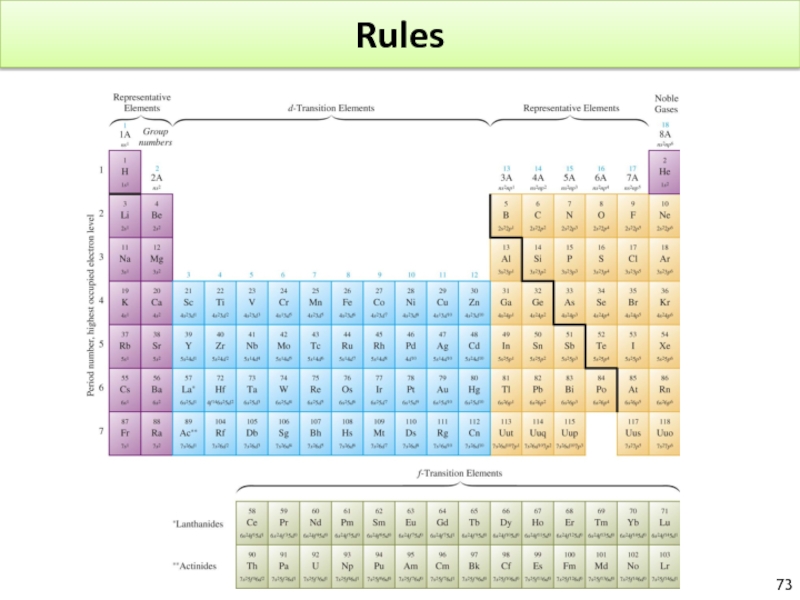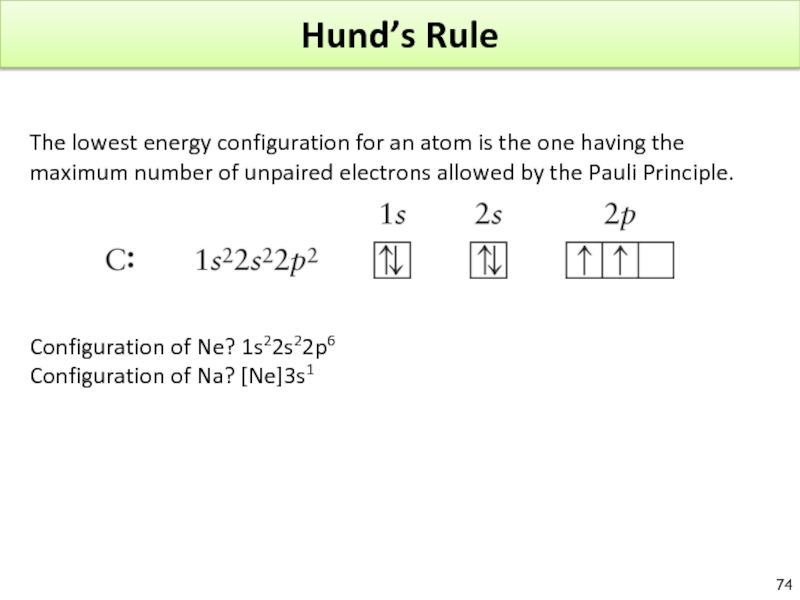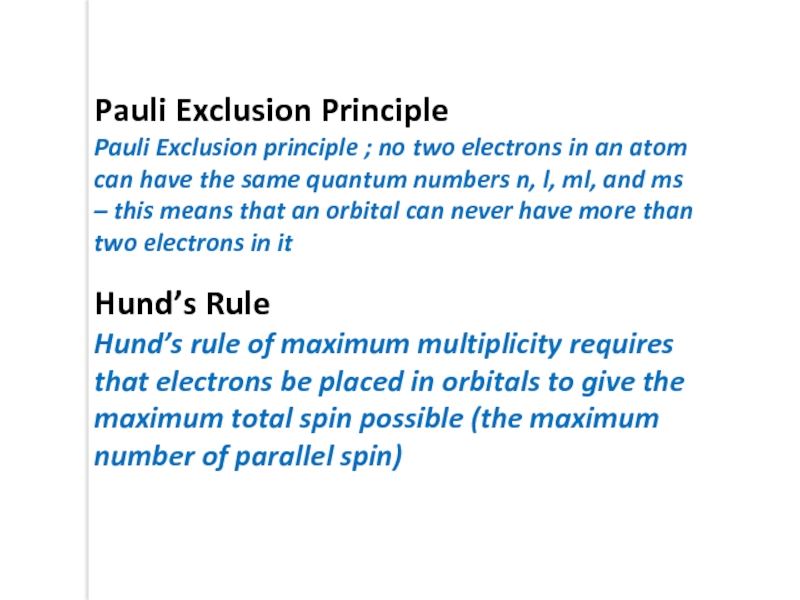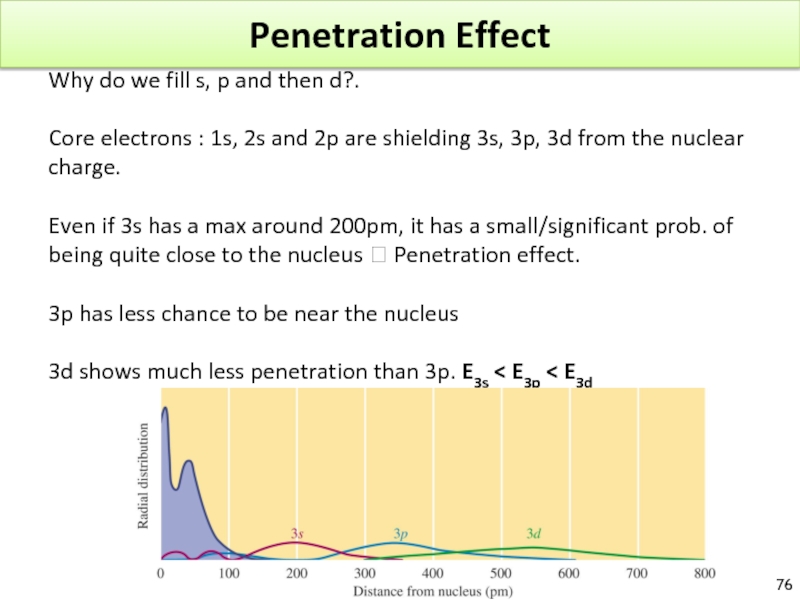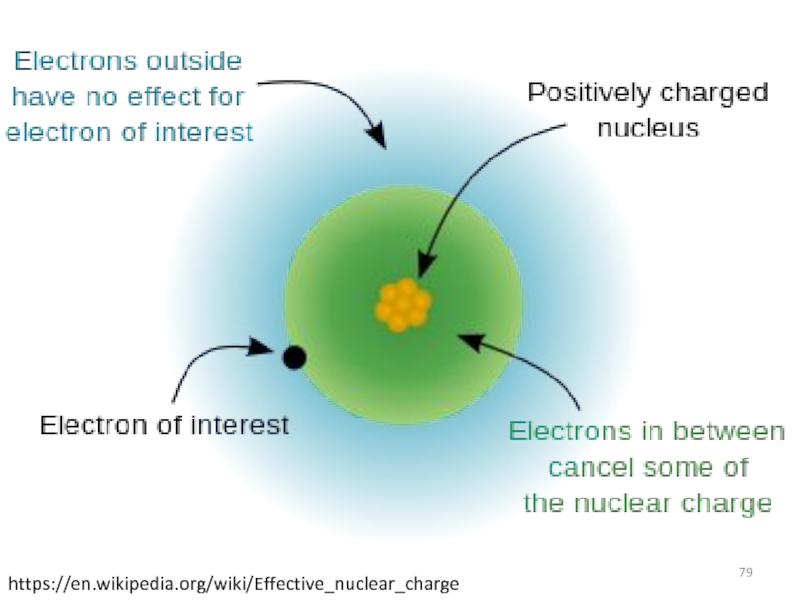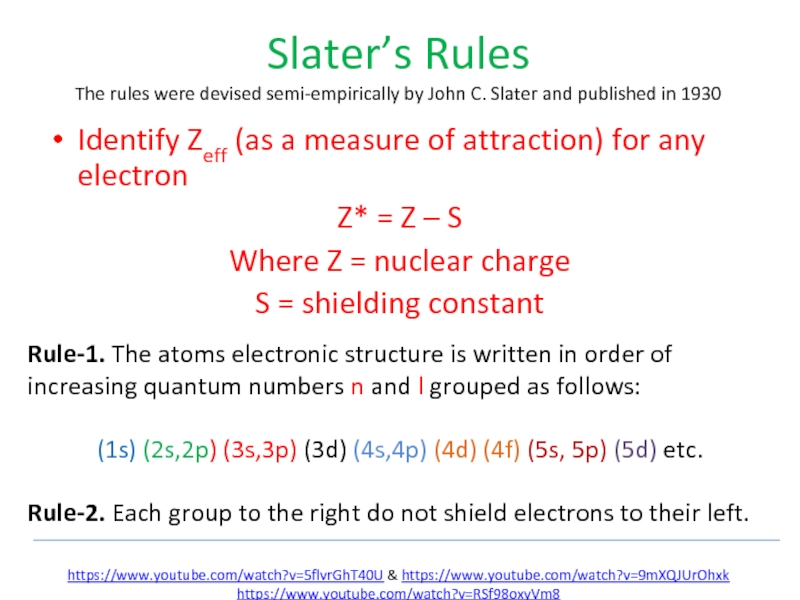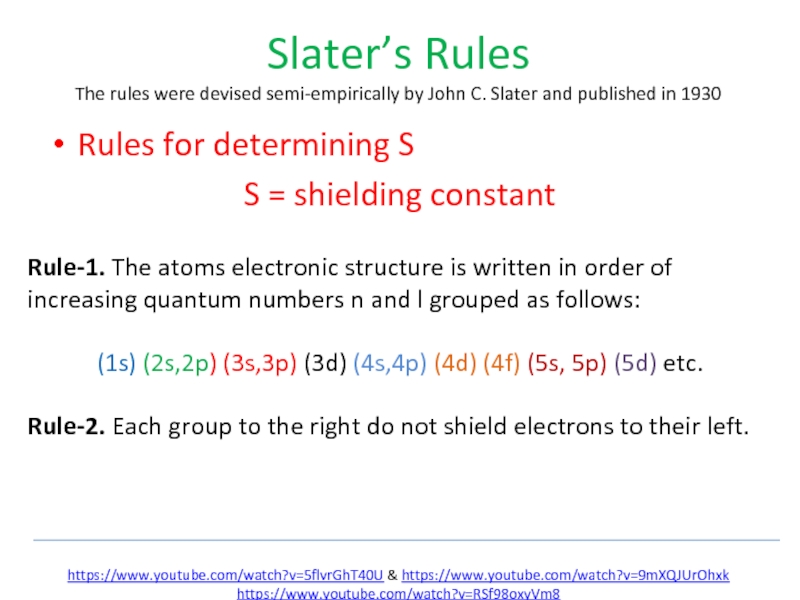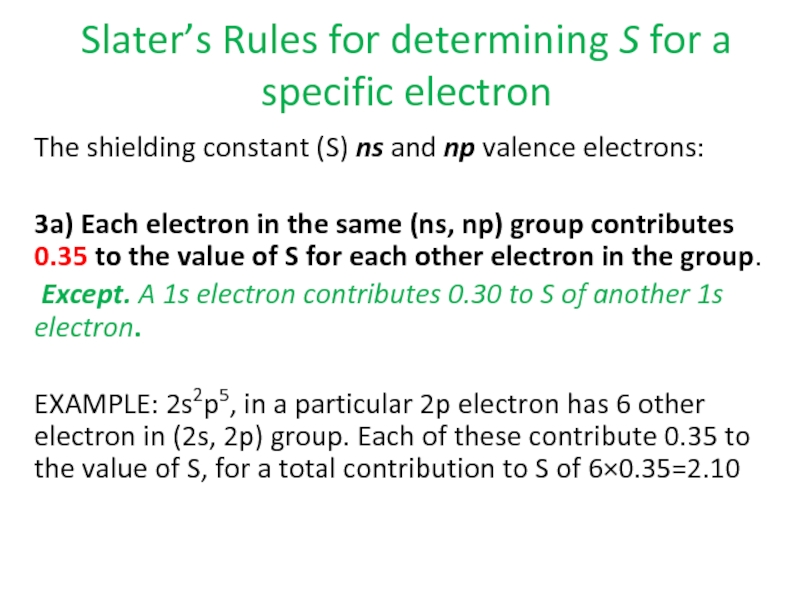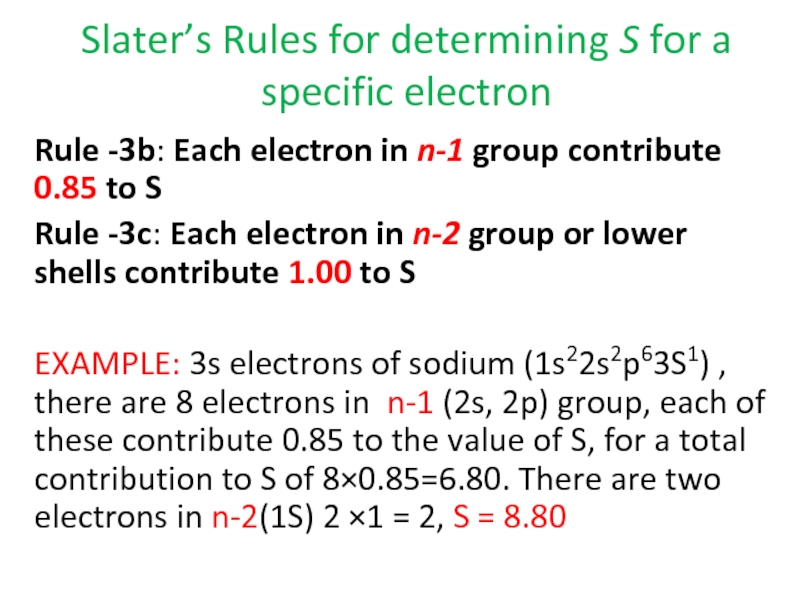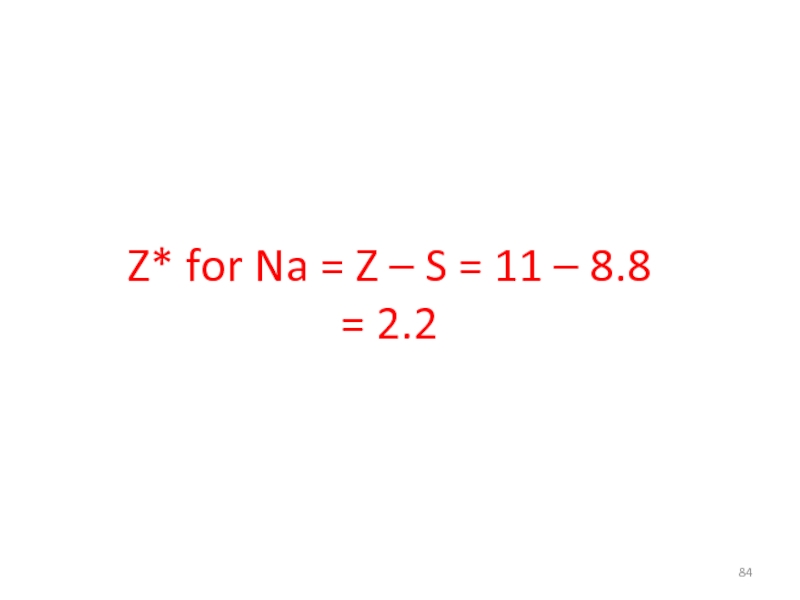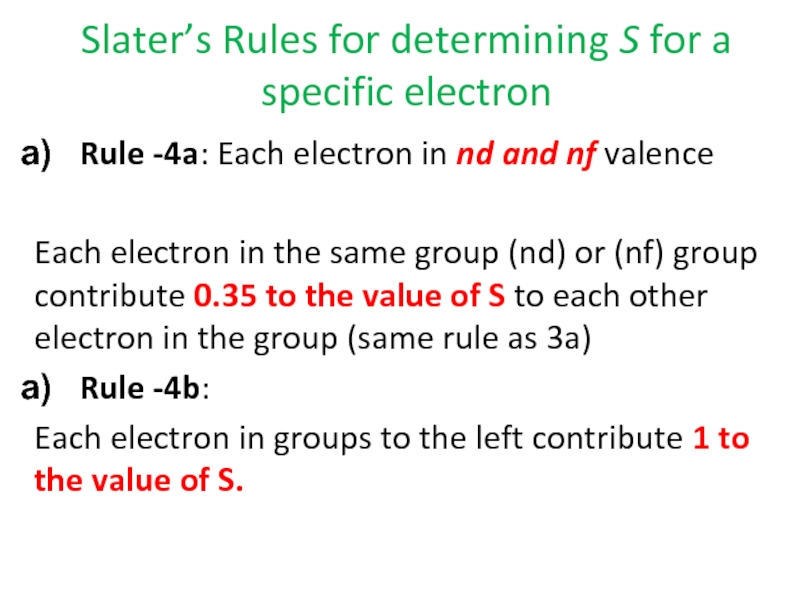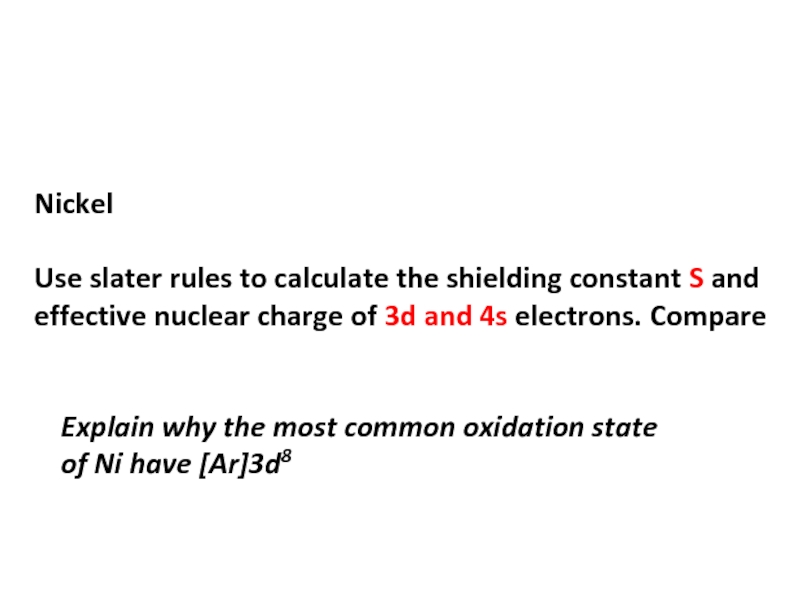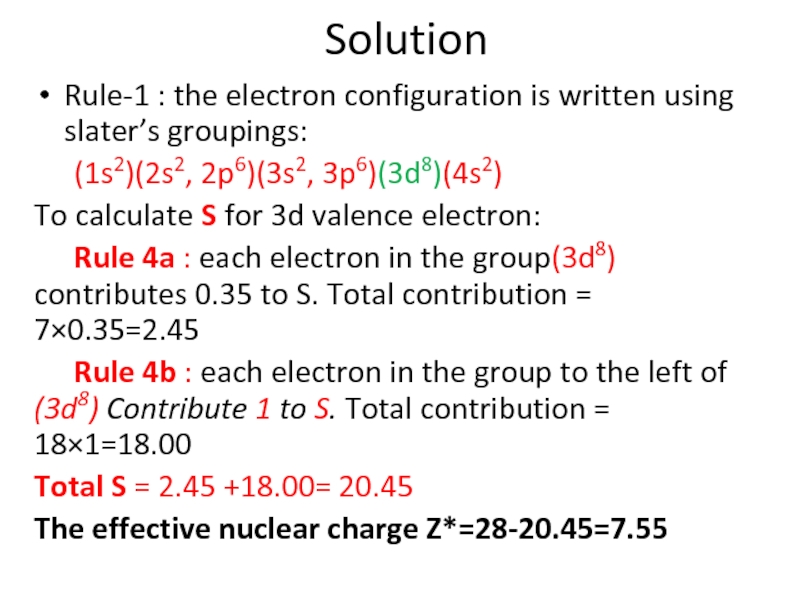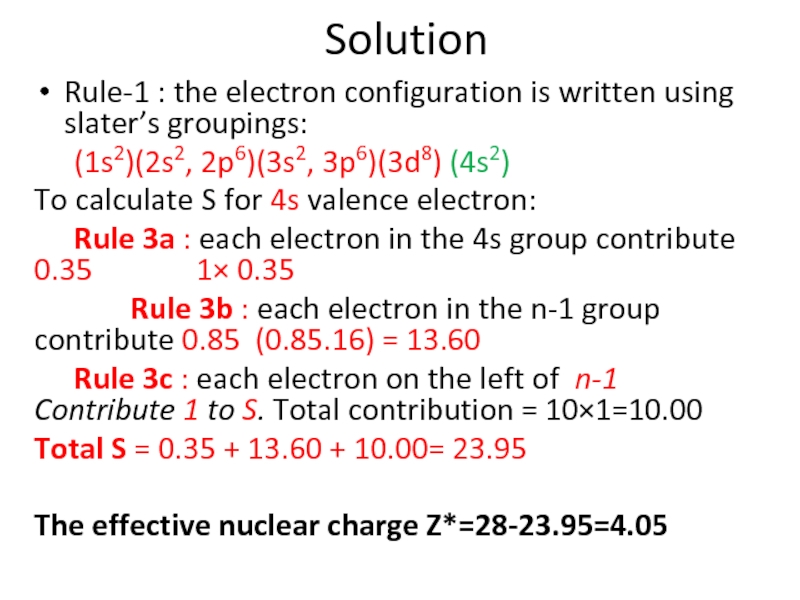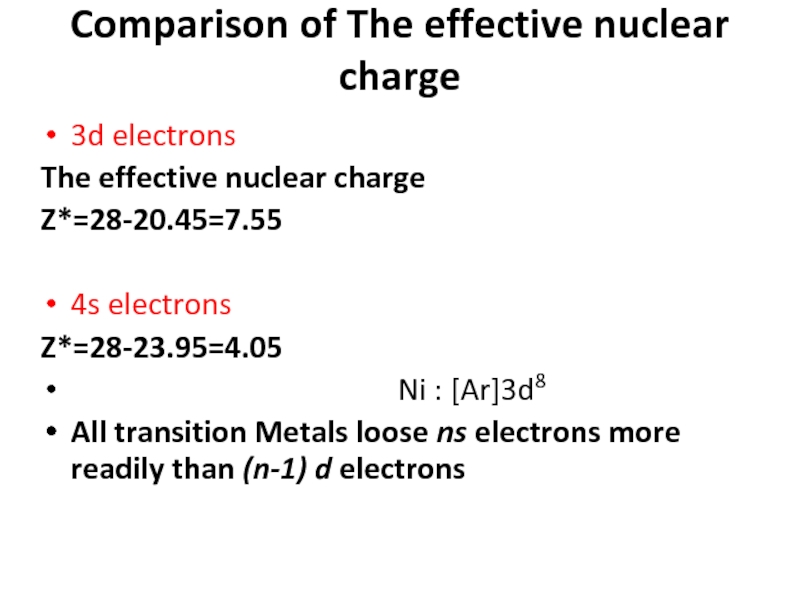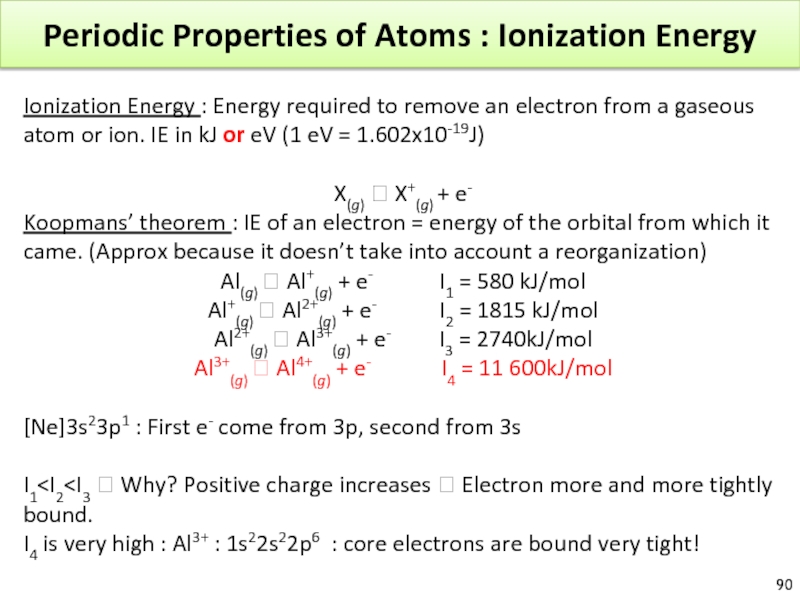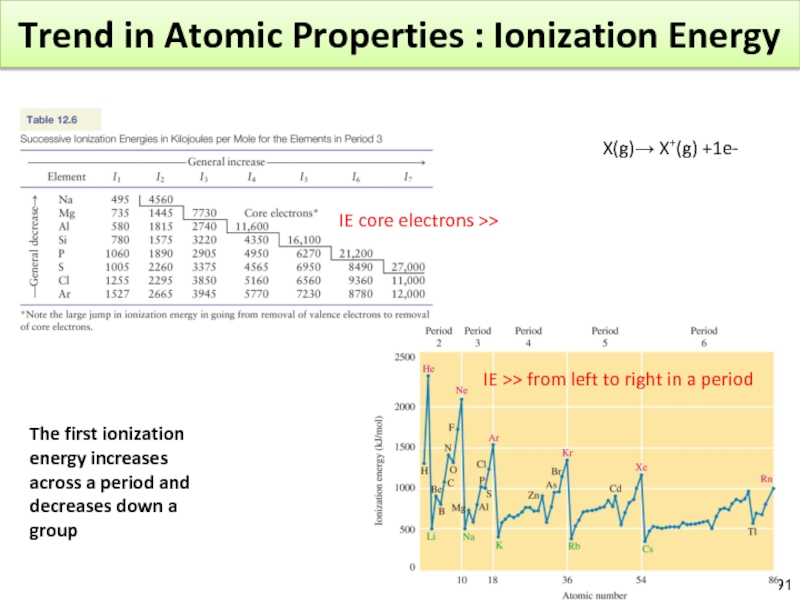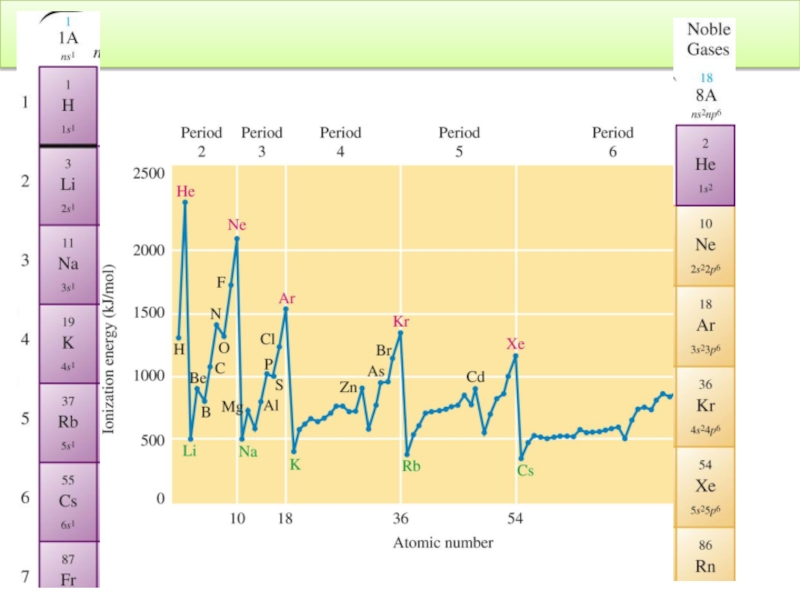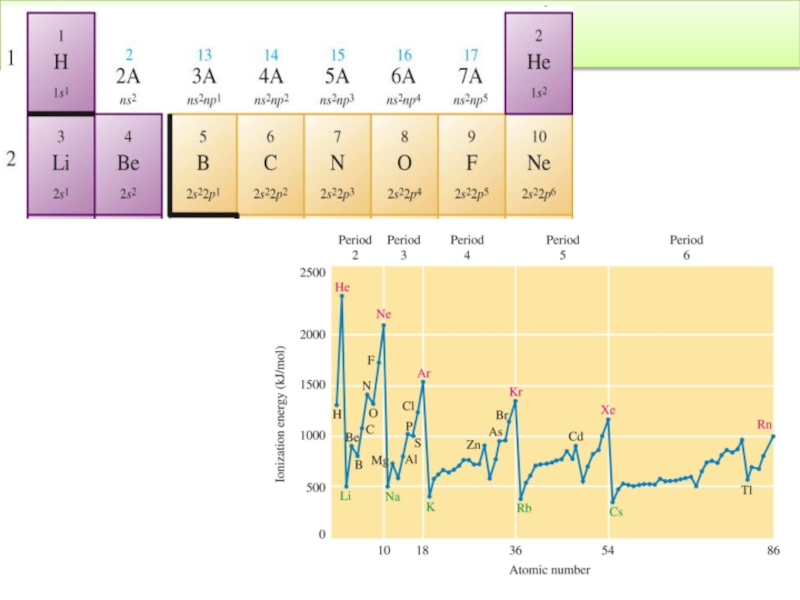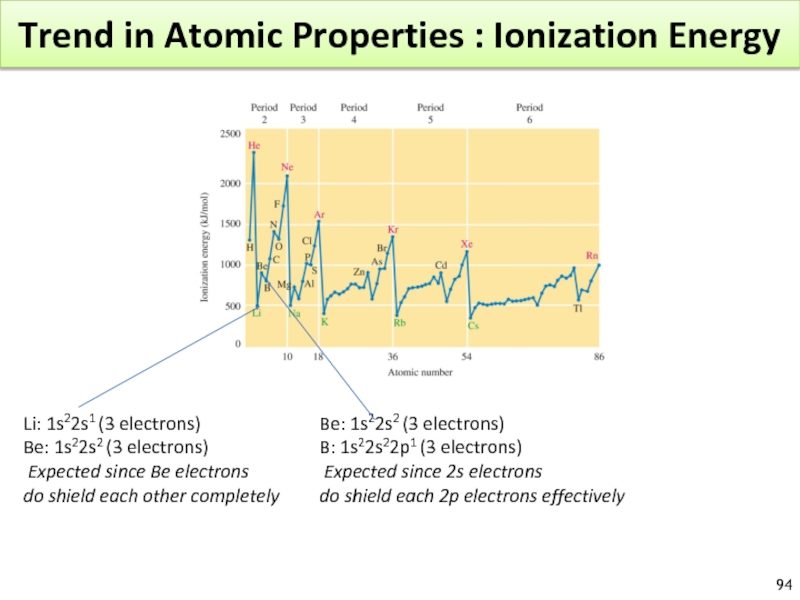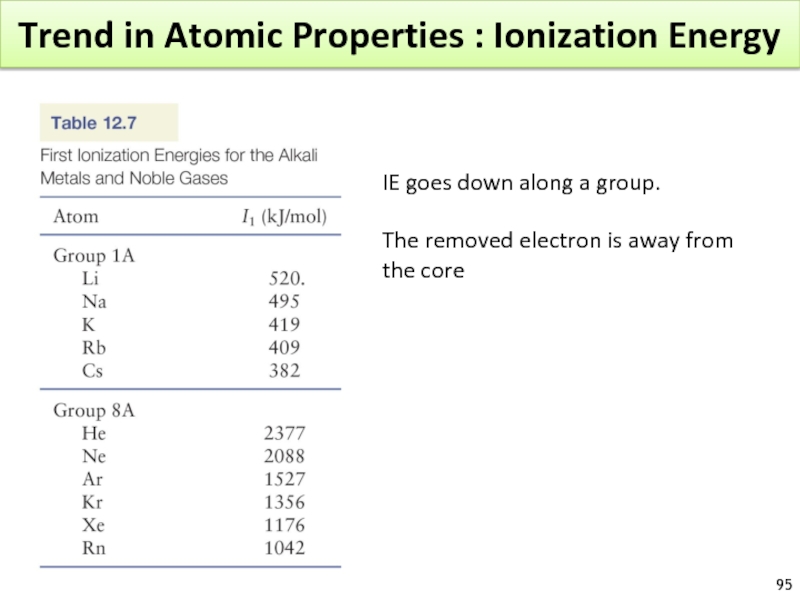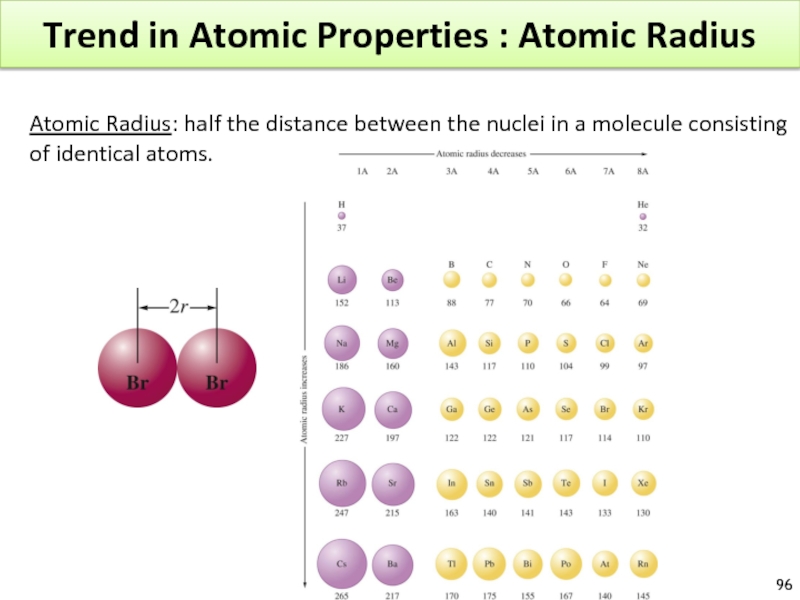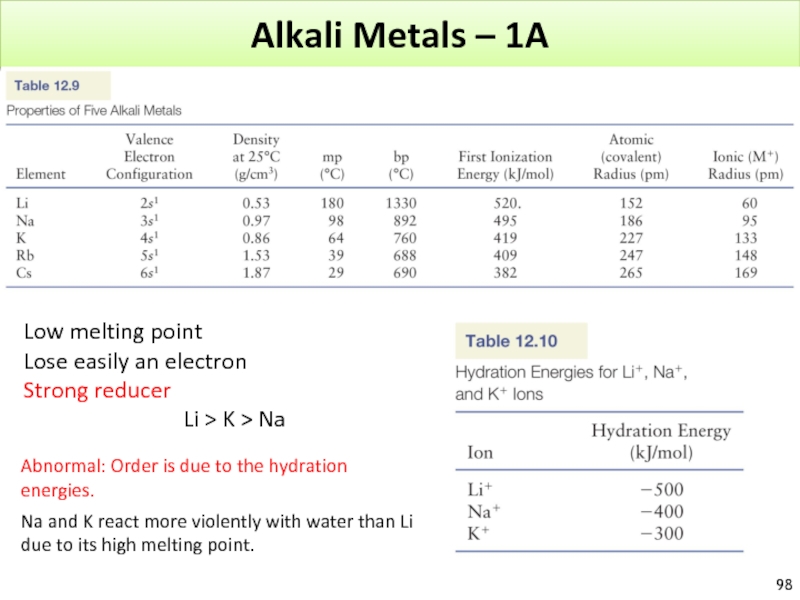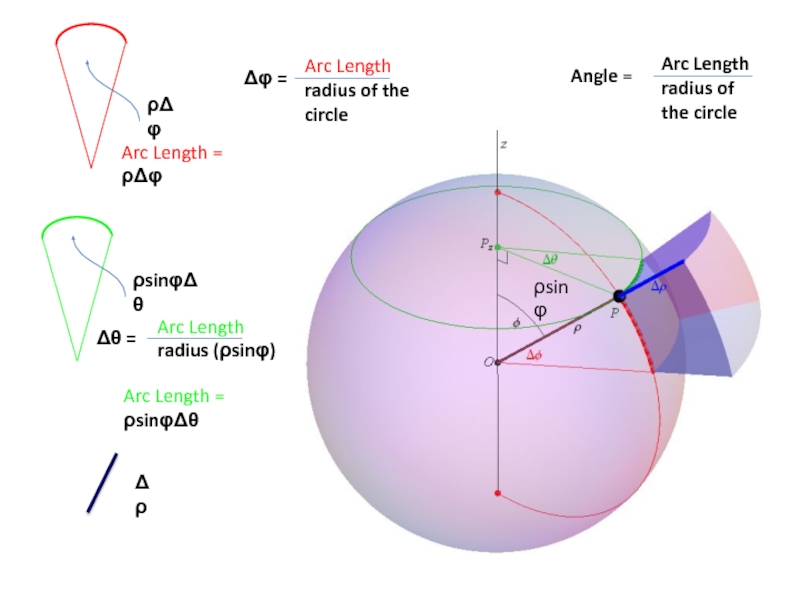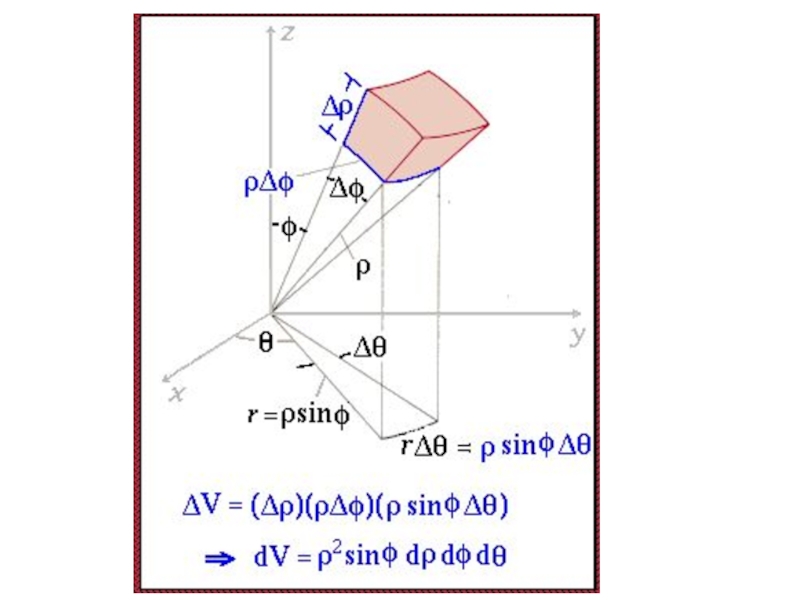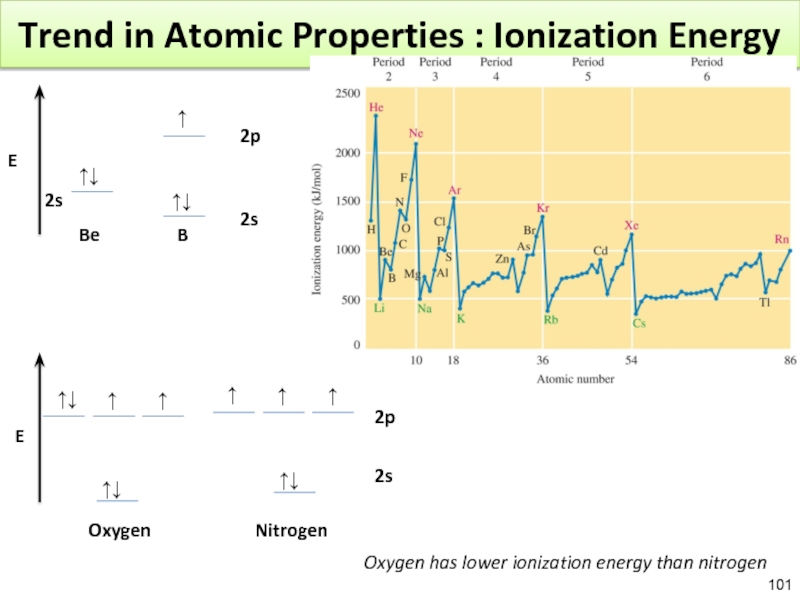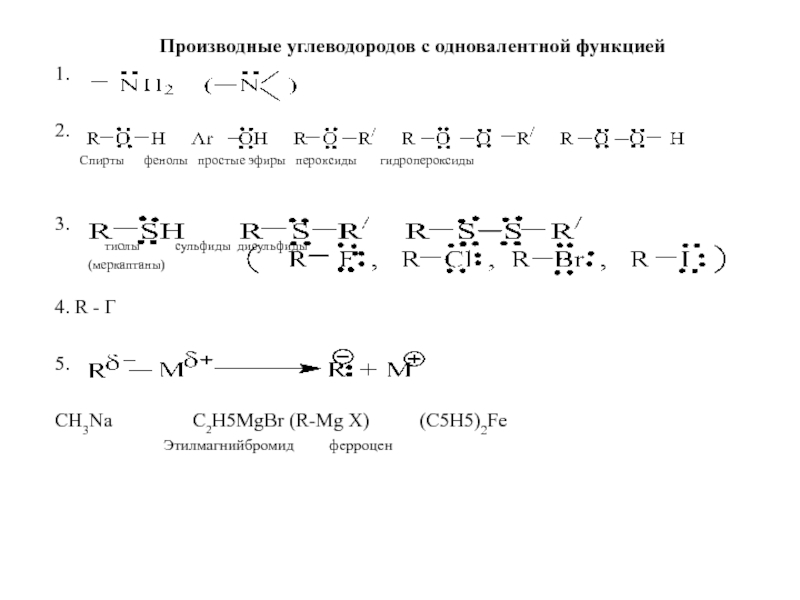- Главная
- Разное
- Дизайн
- Бизнес и предпринимательство
- Аналитика
- Образование
- Развлечения
- Красота и здоровье
- Финансы
- Государство
- Путешествия
- Спорт
- Недвижимость
- Армия
- Графика
- Культурология
- Еда и кулинария
- Лингвистика
- Английский язык
- Астрономия
- Алгебра
- Биология
- География
- Детские презентации
- Информатика
- История
- Литература
- Маркетинг
- Математика
- Медицина
- Менеджмент
- Музыка
- МХК
- Немецкий язык
- ОБЖ
- Обществознание
- Окружающий мир
- Педагогика
- Русский язык
- Технология
- Физика
- Философия
- Химия
- Шаблоны, картинки для презентаций
- Экология
- Экономика
- Юриспруденция
Atomic structure and properties. (Chapter 3) презентация
Содержание
- 1. Atomic structure and properties. (Chapter 3)
- 2. Picture of the Atom Electromagnetic radiation and
- 3. 3.1.1 Atomic concept, 3.1.2 Subatomic particles,
- 4. Dalton Atomic Theory Elements are
- 5. J.J. Thomson’s Cathode Tube Charge-to-mass ratio
- 6. The Atom : J. J. Thomson (1856-1940)
- 7. The Atom based on Thomson’s experiment
- 8. Mass of electron Mass of a single
- 9. Rutherford Experiment Ernest Rutherford – 1911
- 10. Rutherford Experiment
- 11. The Nucleus Ernest Rutherford – 1911
- 12. Modern View
- 13. 3.2. Electromagnetic Radiation and Quantization 3.2.1: Electromagnetic
- 14. Spectrum
- 15. Electromagnetic radiation Light X-ray MRI Microwave Travel
- 16. Electromagnetic Radiation Electromagnetic Radiation = a way
- 17. ELECTROMAGNETIC RADIATION
- 18. Electromagnetic Radiation - Characteristics
- 19. Radio in the 909kHz. What wavelength
- 20. Nature of Matter At
- 21. Photoelectric effect When UV radiation hits a
- 22. E = h x ν E =
- 23. Dual Nature of Light
- 24. De Broglie 1924 λ = h/mν
- 25. Diffraction What is the
- 26. How to test the wave properties of an electron?
- 27. How to test the wave properties of an electron?
- 28. Diffraction When X-rays are
- 29. Conclusion All matter exhibits both particulate and
- 30. Atomic Spectrum of Hydrogen
- 31. Table 3.4. The atomic spectrum of hydrogen
- 33. Atomic Spectrum of Hydrogen
- 34. 3.3.2: The Bohr Model
- 35. The Bohr Model General
- 36. The Bohr Model Example
- 37. Wave Function and Atomic Orbitals 3.5.1 Wave
- 38. De Broglie All moving particles have wave
- 39. 2.2 SCHRONDINGER EQUATION Enter
- 40. Quantum Mechanical Description of the Atom
- 41. The Schrödinger equation The probability distributions and
- 42. Schrodinger Wave Equation
- 43. Kinetic Energy of the Electron
- 44. Kinetic Energy Potential Energy
- 45. Cartesian and Spherical Coordinate
- 46. The wavefunction Atomic wavefunctions are usually
- 47. Homework-2 Please solve problems ; Chapter
- 48. Wave Equation for the Hydrogen Atom
- 49. Quantum numbers : Quantum numbers : n
- 50. Radial and Angular Wave Function for 1s derived from Schrodinger Equation
- 51. Plot of Radial Wave Function = f(r)
- 52. s orbitals Size : 1s
- 53. Physical Meaning of Orbitals
- 54. a1 = 52.9pm radius at n =1 for hydrogen
- 55. a1 = 52.9pm radius at n =1 for hydrogen
- 56. p orbitals Two lobes separated by a
- 57. d orbitals 2 different shapes : dxz,dyz,dxy, dx2-y2 and dz2
- 58. f orbitals Very complex shapes
- 59. Schrödinger Equation Each solution
- 60. Heisenberg uncertainty principle There
- 61. The Hydrogen Atom : summary The quantum
- 62. Polyelectronic Model Schrödinger equation can be
- 63. Self-Consistent Field Method http://www.youtube.com/watch?v=UVkTuOwfOh0
- 64. https://www.youtube.com/watch?v=A6DiVspoZ1E Review this link at home
- 65. Many Electron Atoms Electron spin, Aufbau
- 66. Electron Spin and Pauli Principle A 4th
- 67. History of the Periodic Table Dmitri
- 68. The Aufbau Principle Principle to populate orbitals.
- 69. Valence electrons Valence electrons = electrons from
- 70. Rules
- 71. Rules After 4s2, we fill 3d.
- 72. Rules Element above 118 are generally
- 73. Rules
- 74. Hund’s Rule The lowest energy configuration for
- 75. Pauli Exclusion Principle Pauli Exclusion principle
- 76. Penetration Effect Why do we fill
- 77. Penetration Effect The penetration effect also
- 78. 4s 5g 5s 3p 3s 2p 2s
- 79. https://en.wikipedia.org/wiki/Effective_nuclear_charge
- 80. Slater’s Rules The rules were devised semi-empirically by John C.
- 81. Slater’s Rules The rules were devised semi-empirically by John C.
- 82. Slater’s Rules for determining S for a
- 83. Slater’s Rules for determining S for a
- 84. Z* for Na = Z – S = 11 – 8.8 = 2.2
- 85. Slater’s Rules for determining S for a
- 86. Nickel Use slater rules to calculate
- 87. Solution Rule-1 : the electron configuration is
- 88. Solution Rule-1 : the electron configuration is
- 89. Comparison of The effective nuclear charge
- 90. Periodic Properties of Atoms : Ionization Energy
- 91. Trend in Atomic Properties : Ionization Energy
- 94. Trend in Atomic Properties : Ionization Energy
- 95. Trend in Atomic Properties : Ionization Energy
- 96. Trend in Atomic Properties : Atomic Radius
- 97. END END
- 98. Alkali Metals – 1A Low melting
- 99. ρsinφ Δρ Angle = Arc Length radius of the circle
- 101. Trend in Atomic Properties : Ionization Energy
Слайд 1General Chemistry I
Atomic Structure and Properties
Dr. Ould Ely
School of Science and
Слайд 2Picture of the Atom
Electromagnetic radiation and Atomic Spectra
The Nature of
Many-electron atoms
Atomic properties and Periodicity
Nuclear chemistry
Chapter 3
Слайд 4Dalton Atomic Theory
Elements are made of tiny particles called atoms
2.
3. Chemical compounds are formed when atoms combine with one another. A given compound has the same relative numbers and types of atoms
4. Chemical reaction involve reorganization of the atoms. The atom themselves are not changed.
The classical picture of the atom
Слайд 7The Atom based on Thomson’s experiment
A ray of particles is produced
between
These particles are negatively charged
Since electrons could be produced from electrodes made of various types of metals, all atoms must contain electrons
e/m = -1.76 x 108 C/g
Atoms = neutral! Positive charges are located somewhere.
Слайд 8Mass of electron
Mass of a single electron
e= -1.6x10-19 C m =
http://www.youtube.com/watch?v=XMfYHag7Liw
Слайд 9Rutherford Experiment
Ernest Rutherford – 1911
With Thomson Model : a particles should
http://sun.menloschool.org/~dspence/chemistry/atomic/ruth_expt.html
Слайд 11The Nucleus
Ernest Rutherford – 1911
Conclusion : Dense positive center with electrons
Слайд 133.2. Electromagnetic Radiation and Quantization
3.2.1: Electromagnetic Radiation
3.2.2: Quantization
3.2.3: The Atomic Spectrum
Слайд 15Electromagnetic radiation
Light
X-ray
MRI
Microwave
Travel like a wave
Travel with the speed of light
Слайд 16Electromagnetic Radiation
Electromagnetic Radiation = a way for energy to travel.
2 oscillating
Слайд 18Electromagnetic Radiation - Characteristics
λ = wavelength = distance between two peaks
= frequency = number of waves / s at a specific point of space. (s-1 or Hz)
Because speed = c
= 3x108 m/s
The radiation with the shortest wavelength has the highest frequency
λ ∞ 1/ν
Слайд 19Radio in the 909kHz.
What wavelength does it correspond to?
λ =
C = 2.998 108 ms-1
ν = 909. 103 s-1
Слайд 20Nature of Matter
At the end of the 19th century :
Matter
Matter = particles and Energy = electromagnetic radiations
Max Planck and the black body radiation :
Classic : matter can absorb or emit any quantity of energy ? no maximum ? infinite intensity at very low wavelength.
Quantum : Energy could only be gained or emitted in whole number multiples of hν. h = Plank’s constant = 6.626x10-34Js
Слайд 21Photoelectric effect
When UV radiation hits a metal surface, electrons are ejected
hν = Φ + EKE
Φ - work function – minimum energy required to remove the electron
EKE – kinetic energy of the ejected electron
Albert Einstein Theory :
Energy itself is quantified and radiation could be seen as a stream of particles (photons)!
Слайд 22E = h x ν
E = 6.63 x 10-34 (J•s) x
E = 1.29 x 10 -15 J
E = h x c / λ
When copper is bombarded with high-energy electrons, X rays are emitted. Calculate the energy (in joules) associated with the photons if the wavelength of the X rays is 0.154 nm.
Слайд 23Dual Nature of Light
Energy – Mass relationship :
A particle but also
Summary :
- Energy is quantized
- Only discrete units of energy (quanta) could be transferred
- Dual nature of light
Слайд 25Diffraction
What is the wavelength for an electron?
Me = 9.11x10-31 kg
Ve
1 J = 1 kg.m2/s2
6.626x10-34Js
The electron has a WL similar to the spacing of atoms in a crystal.
Confirmed for Ni crystal.
Diffraction : result of light scattered from a regular array of points or lines.
Слайд 29Conclusion
All matter exhibits both particulate and wave properties.
Large particles : mainly
Small particles : mainly wave
Intermediate particles (electron) : both
Слайд 30Atomic Spectrum of Hydrogen
When a high energy discharge is passed through
Release of energy ? Emission spectrum.
Слайд 33Atomic Spectrum of Hydrogen
Why do we have a line spectrum for
Only certain energies are allowed for the electron in the hydrogen atom.
Energy is quantized!
Слайд 35The Bohr Model
General Idea :
The electron in a hydrogen atom moves
Bohr used classical physics to calculate the radii of these orbits.
At an infinite distance E=0 (n=∞)
Слайд 36The Bohr Model
Example : Energy emitted from n=6 to ground state
The negative sign means that the electron is more tightly bound when
n=1 than when n=6
Слайд 37Wave Function and Atomic Orbitals
3.5.1 Wave properties of matter, Heisenberg uncertainty
3.5.2 Wave-functions and Schrödinger equation
3.5.3 Shapes of atomic orbitals
Слайд 38De Broglie
All moving particles have wave properties
λ=
h
mu
= Wavelength
h = Planck
m = Mass
u = Velocity of the particle
The electron bound to the nucleus is similar to a standing wave.
The waves do not travel.
Node = no displacement of the wave = each end.
? Always a whole number of half-WL.
Слайд 40Quantum Mechanical Description of the Atom
Heisenberg – de Broglie – Schrödinger
Only
ψ = wave function : describes x, y, z of the electron
H = Hamiltonian operator
E = Total Energy of the atom (Ep e-p + Ek e)
– probability of finding an electron at some point is proportional to Ψ Ψ *. Ψ * is the complex conjugate
Слайд 41The Schrödinger equation
The probability distributions and allowed energy levels for electrons
– second order differential equation
– equation has a large number of different solutions
» each corresponds to a different possible probability distribution for the electron
– probability of finding an electron at some point is proportional to Ψ Ψ *. Ψ * is the complex conjugate
Слайд 43
Kinetic Energy of the
Electron Motion
Potential Energy of the
Electron. The
electrostatic attraction
between the electron
and the nucleus. It is
commonly designated as V
Hamiltonian for one Electron
Слайд 46The wavefunction
Atomic wavefunctions are usually expressed in spherical polar coordinates
–
Can write Ψ(r, θ, φ)=R(r) Y(θ, φ)
– R(r) is radial part of wavefunction
– Y(θ, φ) is angular part of wavefunction
Quantum Numbers and Atomic Wavefunctions
https://www.youtube.com/watch?v=sT8JIn7Q_Fo
https://www.youtube.com/watch?v=NpgKGIaE9Zc
x = rsinθcosφ
y = rsinθsinφ
z = rcosθ
Слайд 47Homework-2
Please solve problems ;
Chapter 3
6, 9, 10, 12, 14, 16 and
Due on Wednesday. Recitation time
Слайд 48Wave Equation for the Hydrogen Atom
– R(r) is radial part of
Describes electrons density at different
distances from the nucleus
– Y(θ, φ) is angular part of wavefunction
Describes the shape of the orbitals and
its orientation in space.
In other words:
How the probability changes from point to
point at a given distance from the
center of the atom.
x = rsinθcosφ
y = rsinθsinφ
z = rcosθ
Ψ(x, y, z)= Ψ(r, θ, φ) = R(r) Y(θ, φ)
Слайд 49Quantum numbers :
Quantum numbers :
n = principal quantum number : size
l = angular momentum quantum number : 0 to n-1 : shape of the orbital
ml = magnetic quantum number : -l to +l : orientation in space of the angular momentum
Слайд 53Physical Meaning of Orbitals
The wave function has no easy physical meaning.
The
For 1s orbital : arbitrary accepted size = radius of the sphere that encloses 90% of total electron probability.
Слайд 56p orbitals
Two lobes separated by a node.
Sine function : +
Px, Py, Pz following their orientation
Слайд 59Schrödinger Equation
Each solution ψ of the Schrödinger equation has a specific
A specific wave function for a given electron = orbital
An orbital ≠ orbit.
How does an electron move in an orbit? We don’t know!
Слайд 60Heisenberg uncertainty principle
There is a fundamental limitation to just how precisely
Negligible for macro particles (ball, etc.) but not for small particles!
Слайд 61The Hydrogen Atom : summary
The quantum mechanical model : electron =
Series of wave function (orbitals) that describe the possible energies and spatial distributions available to the electrons.
Heisenberg : the electron motion can’t be defined.
The square of the WF = probability distribution of the electron in an orbital.
The size of the orbital is arbitrarily defined .
Surface that contains 90% of the total electron probability.
The H atom has many orbitals.
In the ground state : e- in 1s.
Слайд 62Polyelectronic Model
Schrödinger equation can be solved exactly only for hydrogen.
Schrödinger equation
It has to be approximated : SCF : Self-Consistent Field by Hartree.
1- A WF (orbital) is guessed for each electron except for electron 1.
2- Schrödinger equation is solved for electron 1
3- The repulsion between 1 and the others electrons are computed
4- ψ1 is found
5- ψ2, etc. are computed
6- The entire process start again until a self-consistent field is obtained
Слайд 65Many Electron Atoms
Electron spin,
Aufbau principle,
Anomalies in electronic configuration, Structure
Part V
Слайд 66Electron Spin and Pauli Principle
A 4th quantum number describe the electron
The electron doesn’t really “spin” = name for the intrinsic angular moment.
ms = +1/2 or -1/2
Pauli exclusion principle : in a given atom no two electrons can have the same set of four quantum numbers.
– An orbital can hold only two electrons and they must have opposite spin.
Слайд 67History of the Periodic Table
Dmitri Mendeleev : ми́трий Менделе́ев
One of first
Allowed prediction of element properties
Arranged known elements according to increasing atomic masses
Mendeleev first stated the periodic law
“The properties of the elements are a periodic function of their atomic
masses”
1834 – 1907
Saint Petersburg - Russia
Later, after more observations, the table was correctly arranged in ORDER OF INCREASING ATOMIC NUMBER
Слайд 69Valence electrons
Valence electrons = electrons from the outermost principal quantum level
Group : Elements in a column : Same valence configuration
Слайд 71Rules
After 4s2, we fill 3d.
Mn : [Ar]4s23d5 – Fe [Ar]4s23d6
Additional Rules:
The
After lanthanum, the lanthanide series occur. ? filling of 4f instead of 5d
After actinium, the actinide series occur. ? filling 5f instead of 6d
Groups 1A?8A indicate the total number of valance electrons.
Groups 1A?8A are main group elements.
2 exceptions to learn by heart : Cr [Ar]4s1d5 and Cu [Ar]4s13d10
Слайд 72Rules
Element above 118
are generally unstable
G contain 9 orbitals l = n-1
Слайд 74Hund’s Rule
The lowest energy configuration for an atom is the one
Configuration of Ne? 1s22s22p6
Configuration of Na? [Ne]3s1
Слайд 75
Pauli Exclusion Principle
Pauli Exclusion principle ; no two electrons in an
– this means that an orbital can never have more than two electrons in it
Hund’s Rule
Hund’s rule of maximum multiplicity requires that electrons be placed in orbitals to give the maximum total spin possible (the maximum number of parallel spin)
Слайд 76Penetration Effect
Why do we fill s, p and then d?.
Core
Even if 3s has a max around 200pm, it has a small/significant prob. of being quite close to the nucleus ? Penetration effect.
3p has less chance to be near the nucleus
3d shows much less penetration than 3p. E3s < E3p < E3d
Слайд 77Penetration Effect
The penetration effect also explains why 4s is filled before
Potassium : 1S22S22P63S23P64S1 rather than 1S22S22P63S23P63d1
An electron in a 4S penetrate much more than an electron in a 3d orbital, as shown
Graphically. (qualitative explanation)
Слайд 784s
5g
5s
3p
3s
2p
2s
Slater rules provide an approximate
Guide explain why certain orbitals
fill
Слайд 80Slater’s Rules
The rules were devised semi-empirically by John C. Slater and published in 1930
Identify Zeff
Z* = Z – S
Where Z = nuclear charge
S = shielding constant
https://www.youtube.com/watch?v=5flvrGhT40U & https://www.youtube.com/watch?v=9mXQJUrOhxk
https://www.youtube.com/watch?v=RSf98oxyVm8
Rule-1. The atoms electronic structure is written in order of increasing quantum numbers n and l grouped as follows:
(1s) (2s,2p) (3s,3p) (3d) (4s,4p) (4d) (4f) (5s, 5p) (5d) etc.
Rule-2. Each group to the right do not shield electrons to their left.
Слайд 81Slater’s Rules
The rules were devised semi-empirically by John C. Slater and published in 1930
Rules for
S = shielding constant
https://www.youtube.com/watch?v=5flvrGhT40U & https://www.youtube.com/watch?v=9mXQJUrOhxk
https://www.youtube.com/watch?v=RSf98oxyVm8
Rule-1. The atoms electronic structure is written in order of increasing quantum numbers n and l grouped as follows:
(1s) (2s,2p) (3s,3p) (3d) (4s,4p) (4d) (4f) (5s, 5p) (5d) etc.
Rule-2. Each group to the right do not shield electrons to their left.
Слайд 82Slater’s Rules for determining S for a specific electron
The shielding constant
3a) Each electron in the same (ns, np) group contributes 0.35 to the value of S for each other electron in the group.
Except. A 1s electron contributes 0.30 to S of another 1s electron.
EXAMPLE: 2s2p5, in a particular 2p electron has 6 other electron in (2s, 2p) group. Each of these contribute 0.35 to the value of S, for a total contribution to S of 6×0.35=2.10
Слайд 83Slater’s Rules for determining S for a specific electron
Rule -3b: Each
Rule -3c: Each electron in n-2 group or lower shells contribute 1.00 to S
EXAMPLE: 3s electrons of sodium (1s22s2p63S1) , there are 8 electrons in n-1 (2s, 2p) group, each of these contribute 0.85 to the value of S, for a total contribution to S of 8×0.85=6.80. There are two electrons in n-2(1S) 2 ×1 = 2, S = 8.80
Слайд 85Slater’s Rules for determining S for a specific electron
Rule -4a: Each
Each electron in the same group (nd) or (nf) group contribute 0.35 to the value of S to each other electron in the group (same rule as 3a)
Rule -4b:
Each electron in groups to the left contribute 1 to the value of S.
Слайд 86Nickel
Use slater rules to calculate the shielding constant S and effective
Explain why the most common oxidation state
of Ni have [Ar]3d8
Слайд 87Solution
Rule-1 : the electron configuration is written using slater’s groupings:
(1s2)(2s2, 2p6)(3s2,
To calculate S for 3d valence electron:
Rule 4a : each electron in the group(3d8) contributes 0.35 to S. Total contribution = 7×0.35=2.45
Rule 4b : each electron in the group to the left of (3d8) Contribute 1 to S. Total contribution = 18×1=18.00
Total S = 2.45 +18.00= 20.45
The effective nuclear charge Z*=28-20.45=7.55
Слайд 88Solution
Rule-1 : the electron configuration is written using slater’s groupings:
(1s2)(2s2, 2p6)(3s2,
To calculate S for 4s valence electron:
Rule 3a : each electron in the 4s group contribute 0.35 1× 0.35
Rule 3b : each electron in the n-1 group contribute 0.85 (0.85.16) = 13.60
Rule 3c : each electron on the left of n-1 Contribute 1 to S. Total contribution = 10×1=10.00
Total S = 0.35 + 13.60 + 10.00= 23.95
The effective nuclear charge Z*=28-23.95=4.05
Слайд 89Comparison of The effective nuclear charge
3d electrons
The effective nuclear charge
Z*=28-20.45=7.55
4s electrons
Z*=28-23.95=4.05
Ni : [Ar]3d8
All transition Metals loose ns electrons more readily than (n-1) d electrons
Слайд 90Periodic Properties of Atoms : Ionization Energy
Ionization Energy : Energy required
X(g) ? X+(g) + e-
Koopmans’ theorem : IE of an electron = energy of the orbital from which it came. (Approx because it doesn’t take into account a reorganization)
Al(g) ? Al+(g) + e- I1 = 580 kJ/mol
Al+(g) ? Al2+(g) + e- I2 = 1815 kJ/mol
Al2+(g) ? Al3+(g) + e- I3 = 2740kJ/mol
Al3+(g) ? Al4+(g) + e- I4 = 11 600kJ/mol
[Ne]3s23p1 : First e- come from 3p, second from 3s
I1
Слайд 91Trend in Atomic Properties : Ionization Energy
IE core electrons >>
IE >>
X(g)→ X+(g) +1e-
The first ionization energy increases across a period and decreases down a group
Слайд 94Trend in Atomic Properties : Ionization Energy
Li: 1s22s1 (3 electrons)
Be:
Expected since Be electrons
do shield each other completely
Be: 1s22s2 (3 electrons)
B: 1s22s22p1 (3 electrons)
Expected since 2s electrons
do shield each 2p electrons effectively
Слайд 95Trend in Atomic Properties : Ionization Energy
IE goes down along a
The removed electron is away from the core
Слайд 96Trend in Atomic Properties : Atomic Radius
Atomic Radius: half the distance
Слайд 98Alkali Metals – 1A
Low melting point
Lose easily an electron
Strong reducer
Na and K react more violently with water than Li
due to its high melting point.
Abnormal: Order is due to the hydration energies.
Слайд 101Trend in Atomic Properties : Ionization Energy
↑↓
↑↓
↑
Be
E
2s
2s
2p
↑↓
↑
Oxygen Nitrogen
E
2s
2p
↑
↑
↑↓
↑↓
↑
↑
Oxygen has lower ionization energy than nitrogen

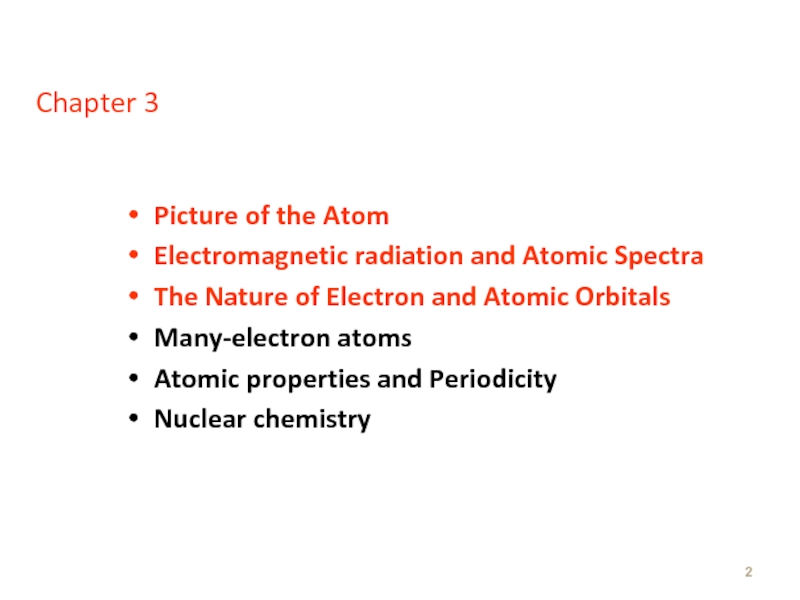
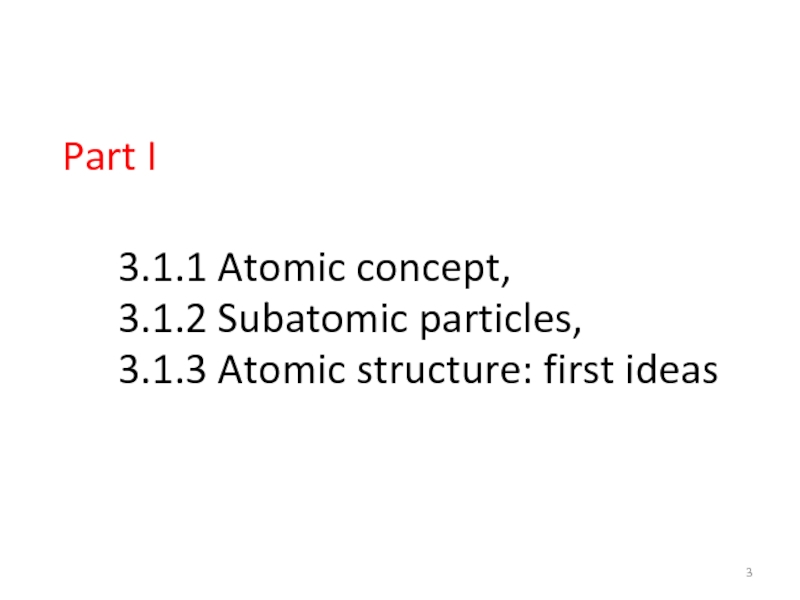
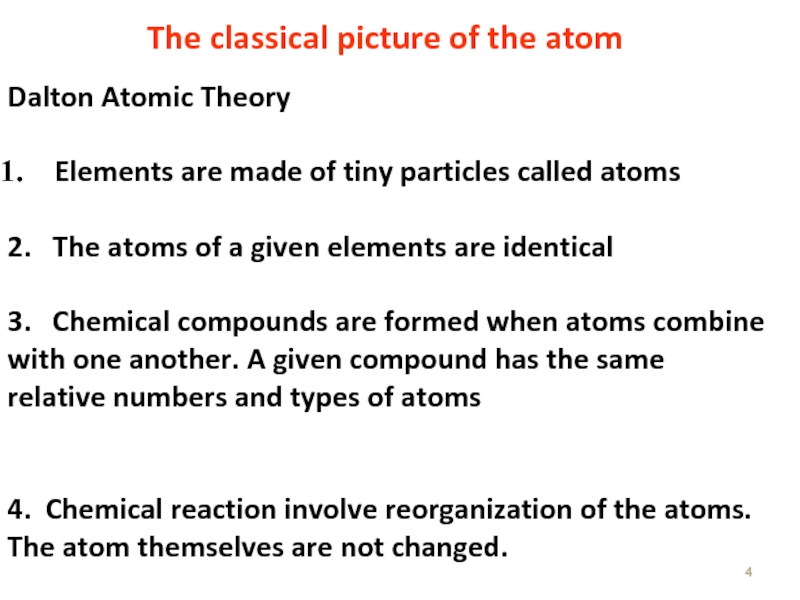
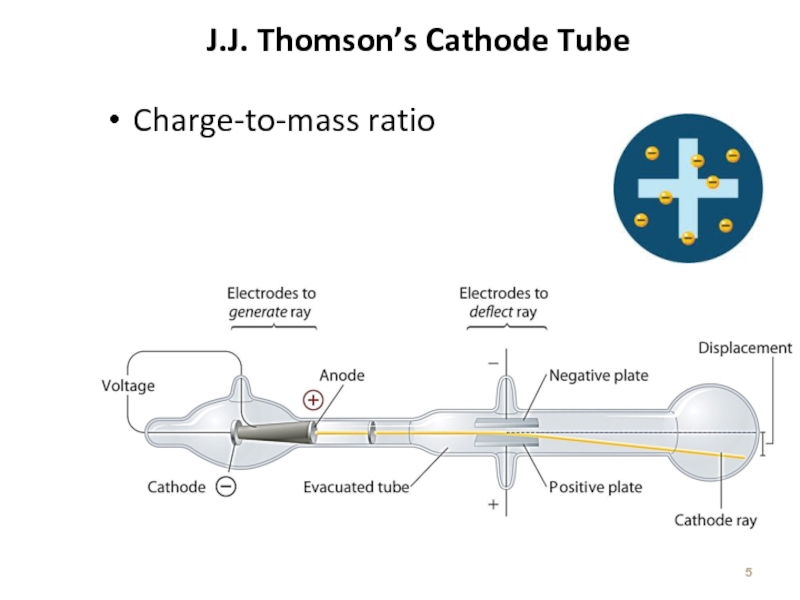
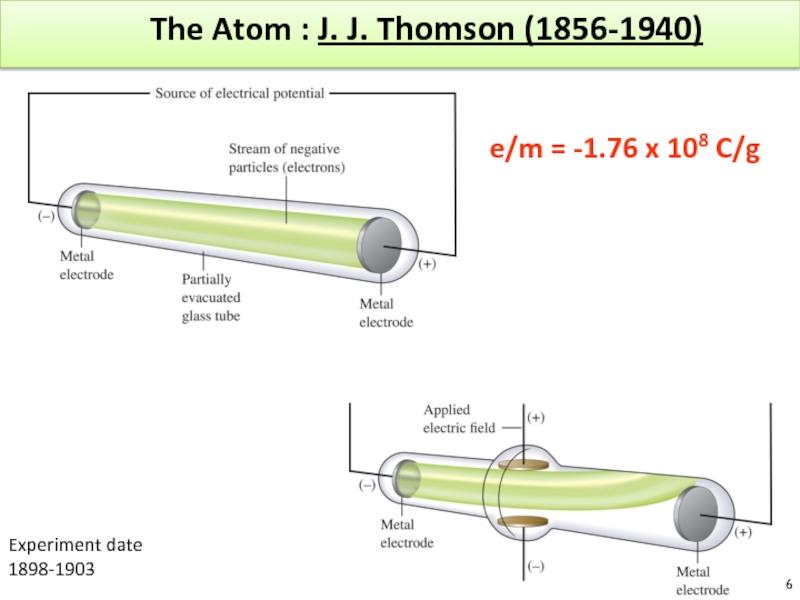
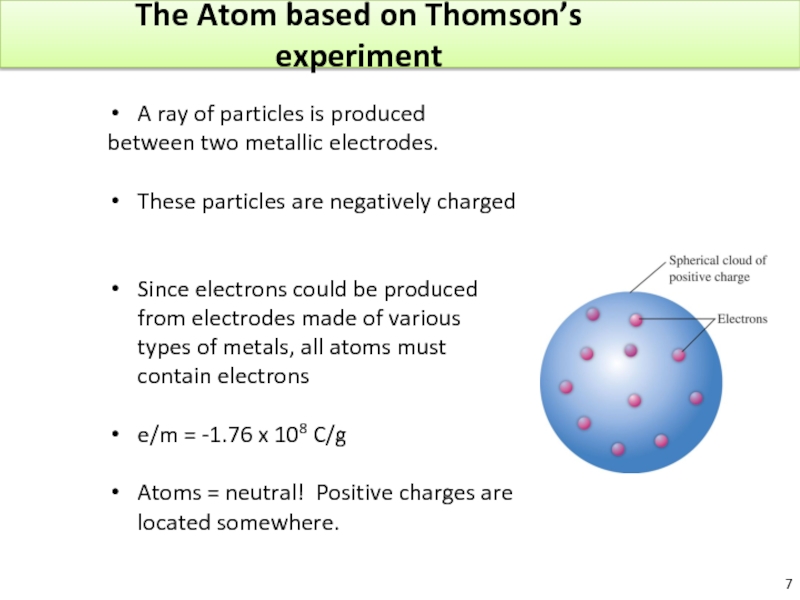
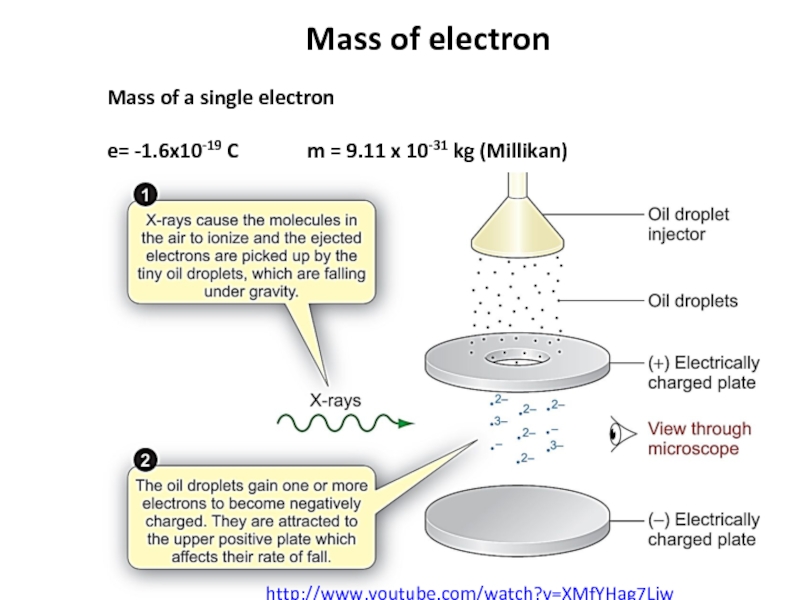

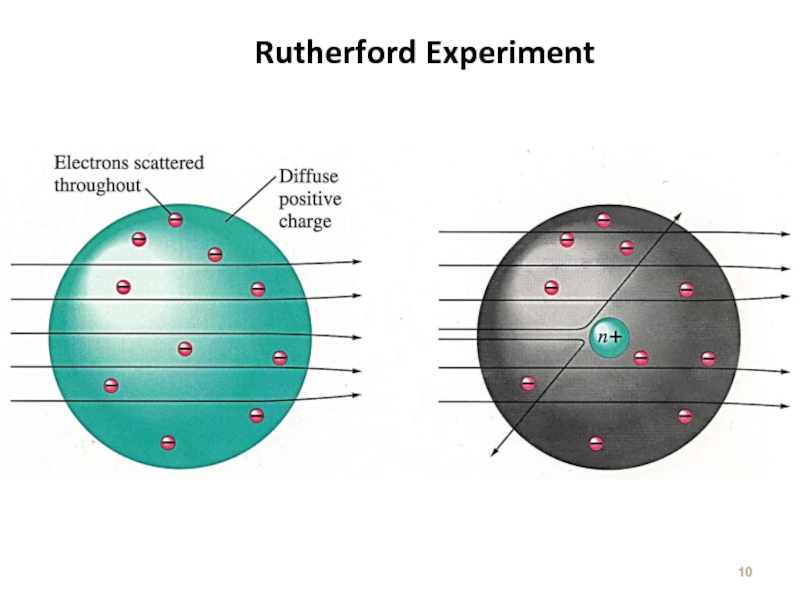
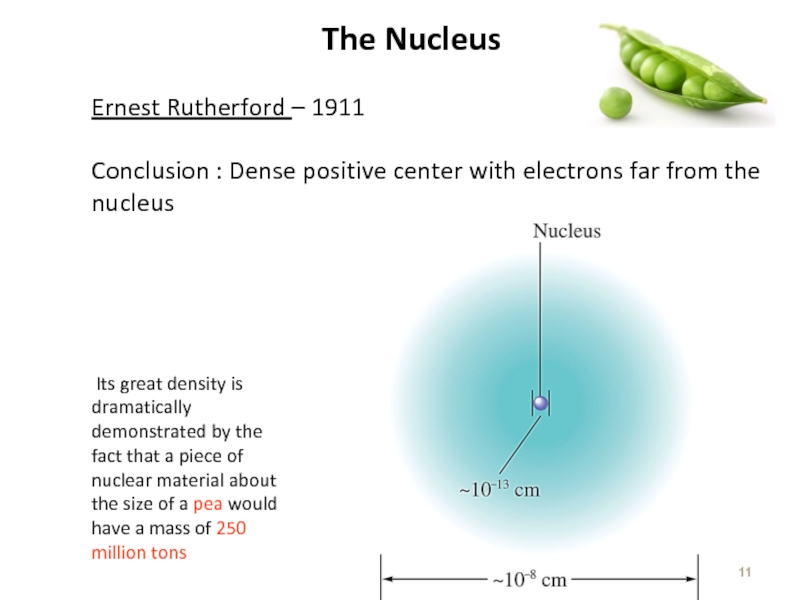
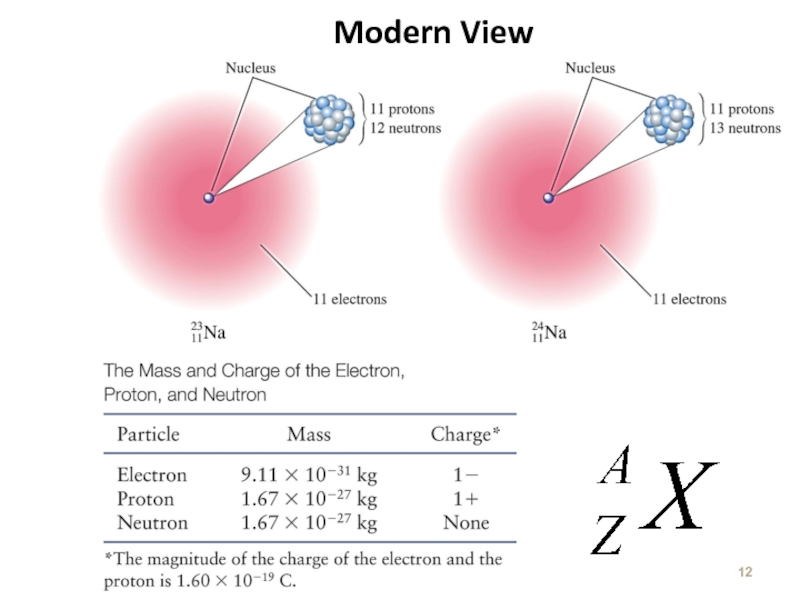
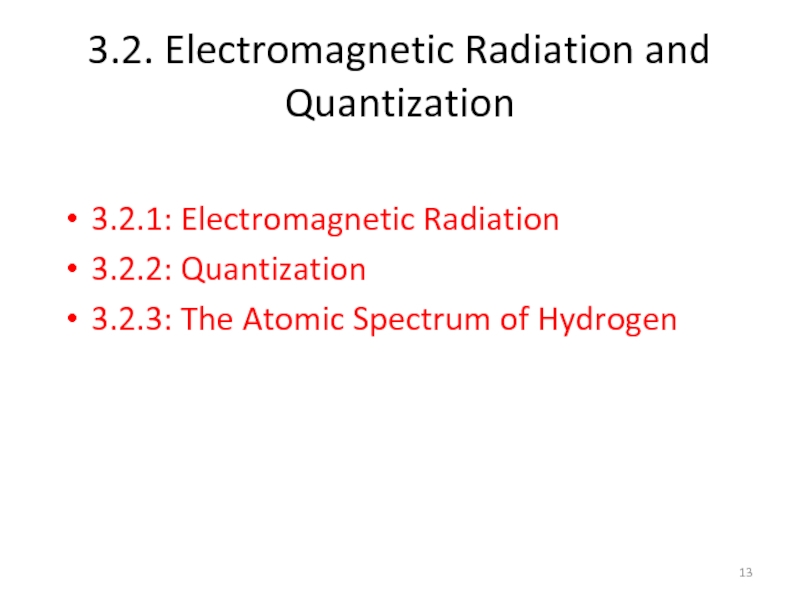
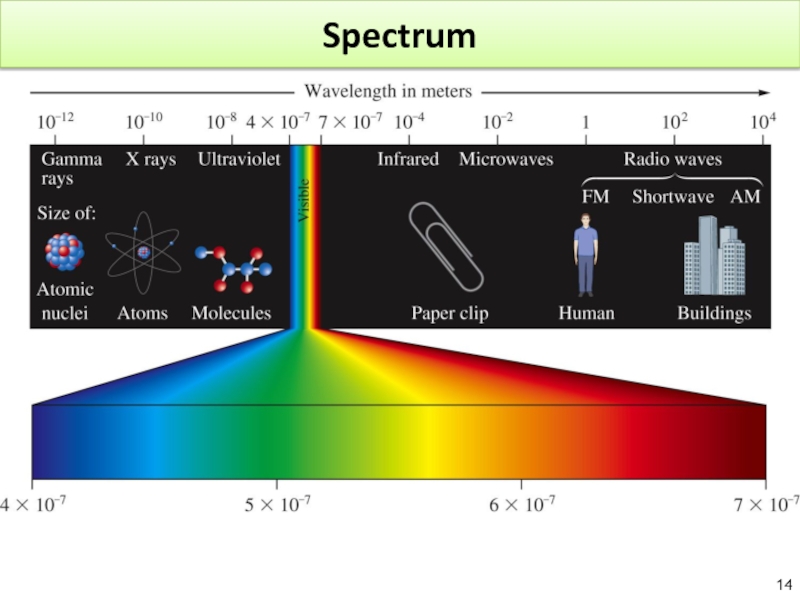
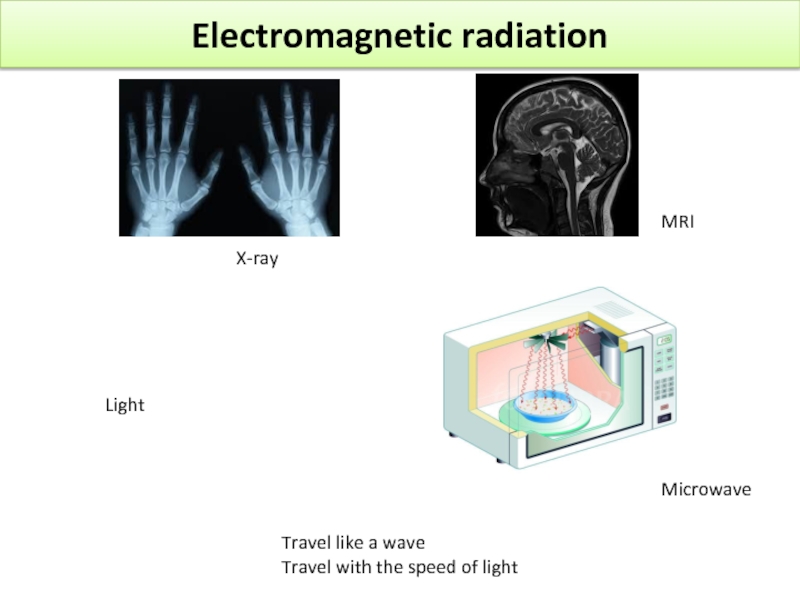
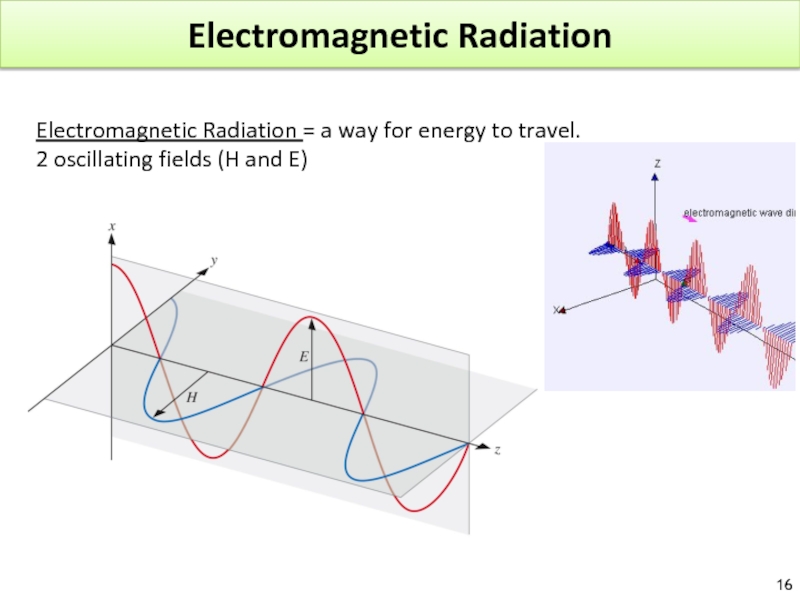
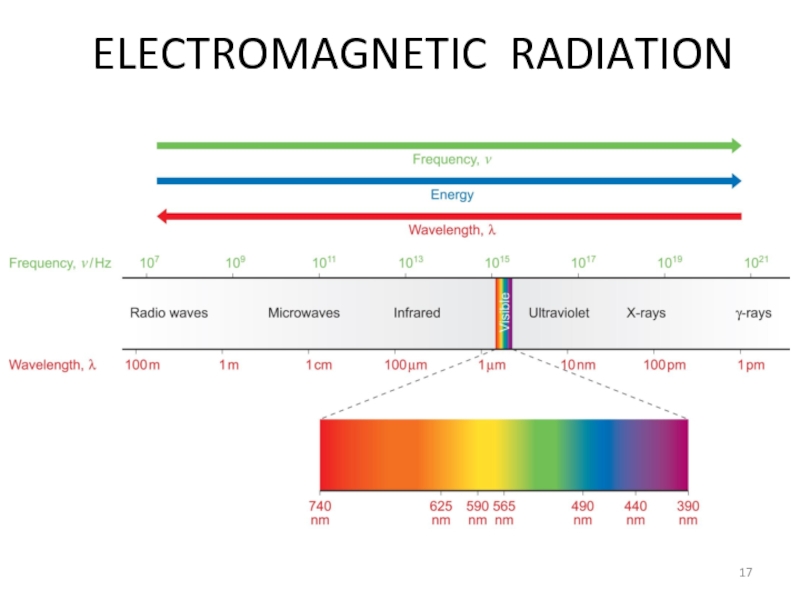
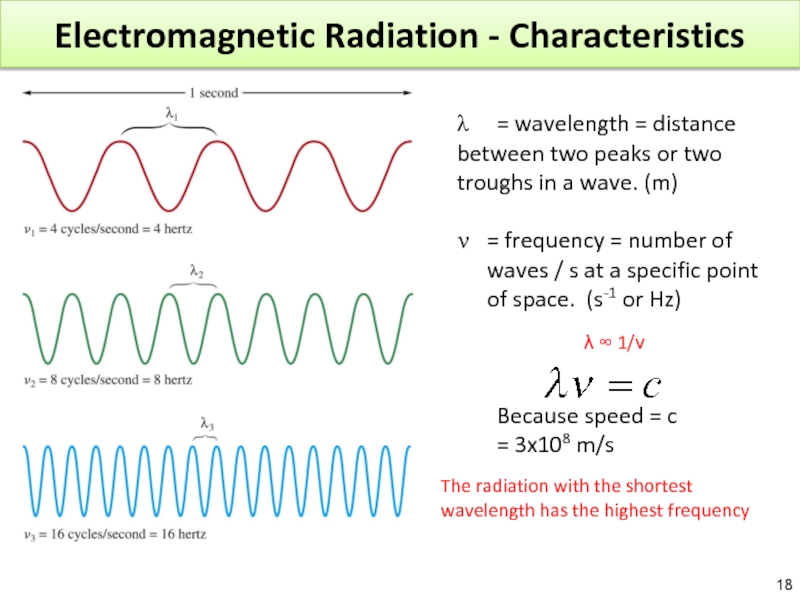
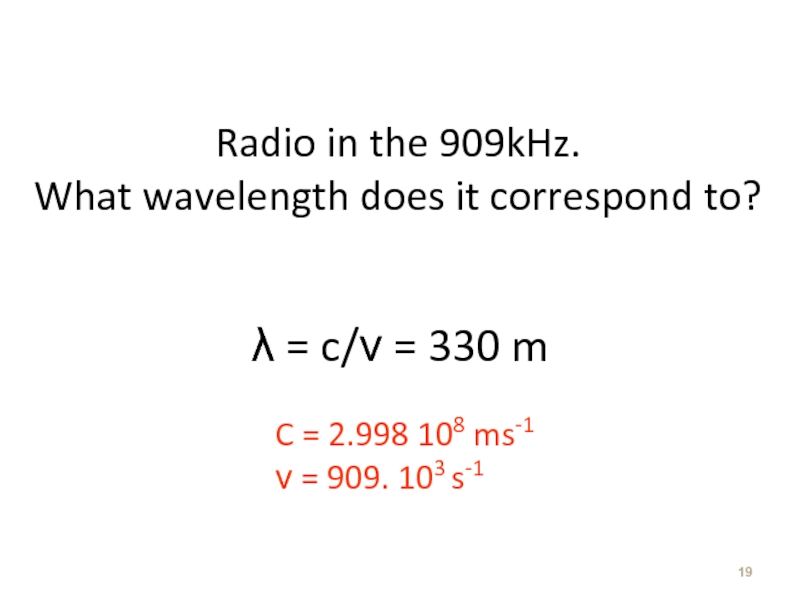
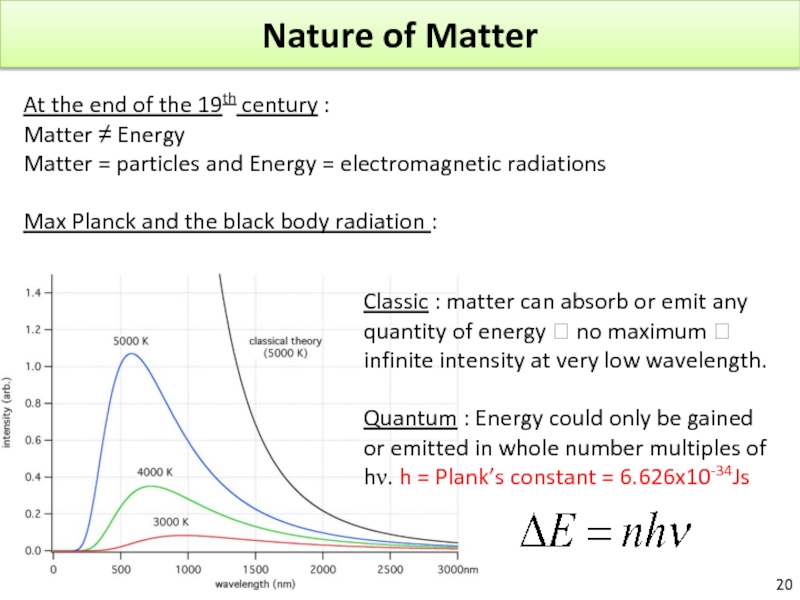
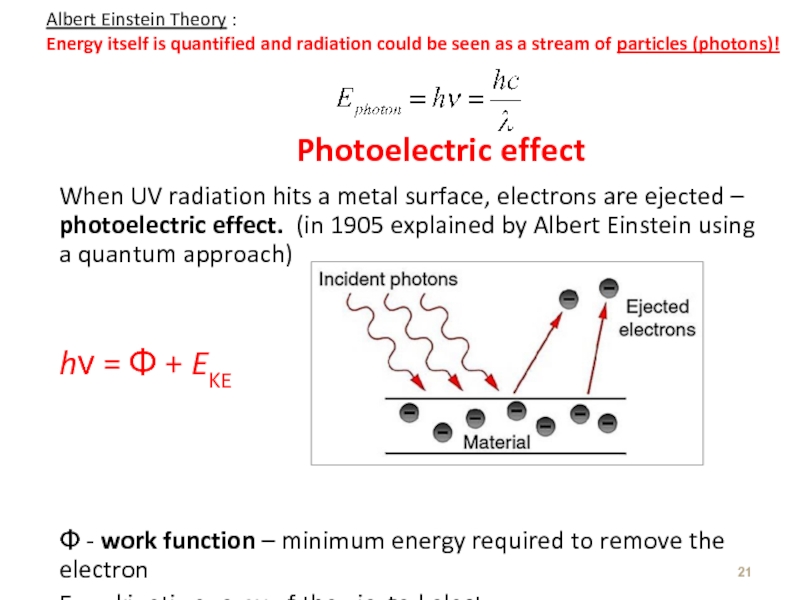
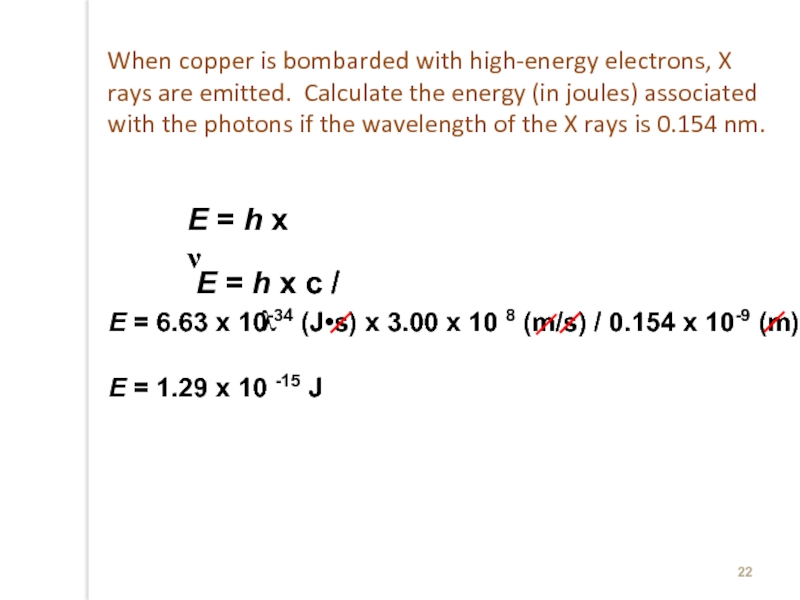
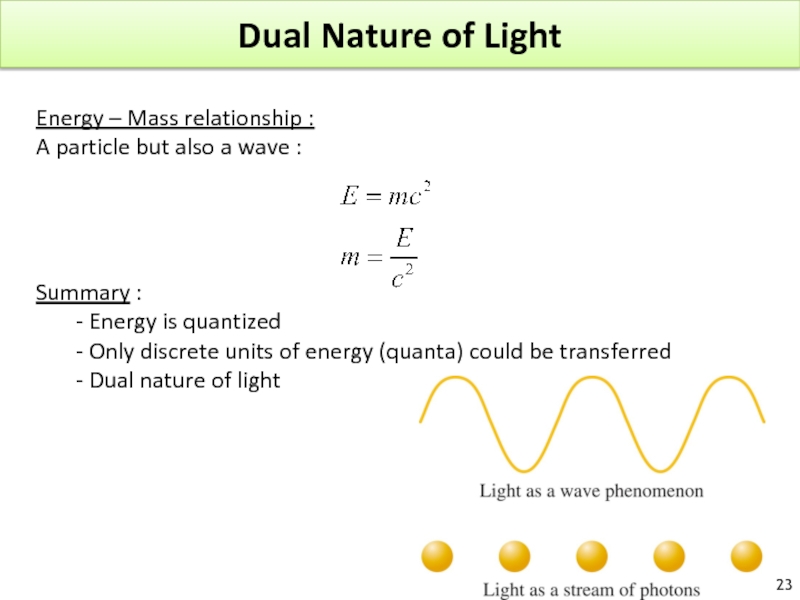

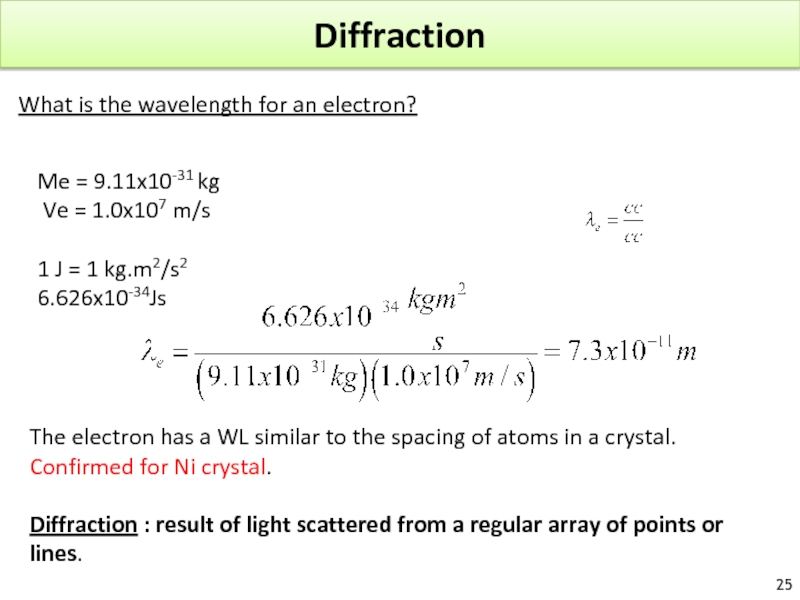
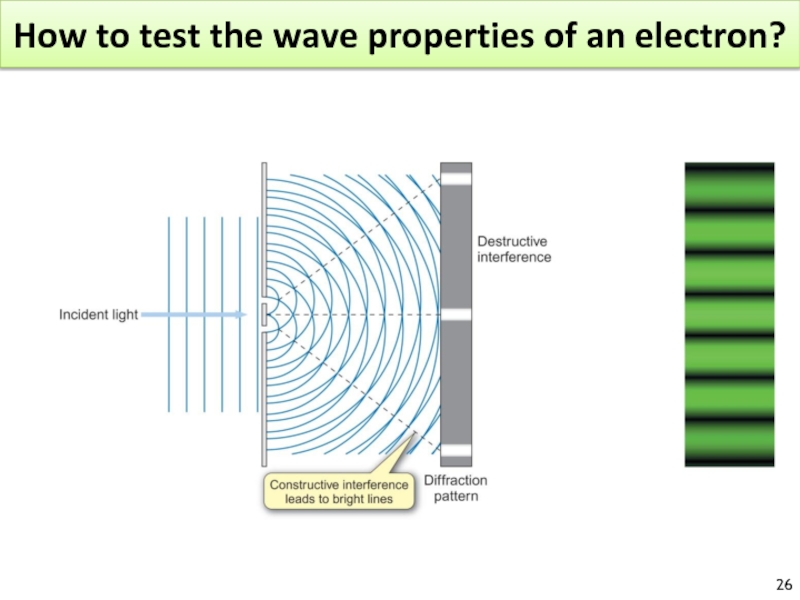
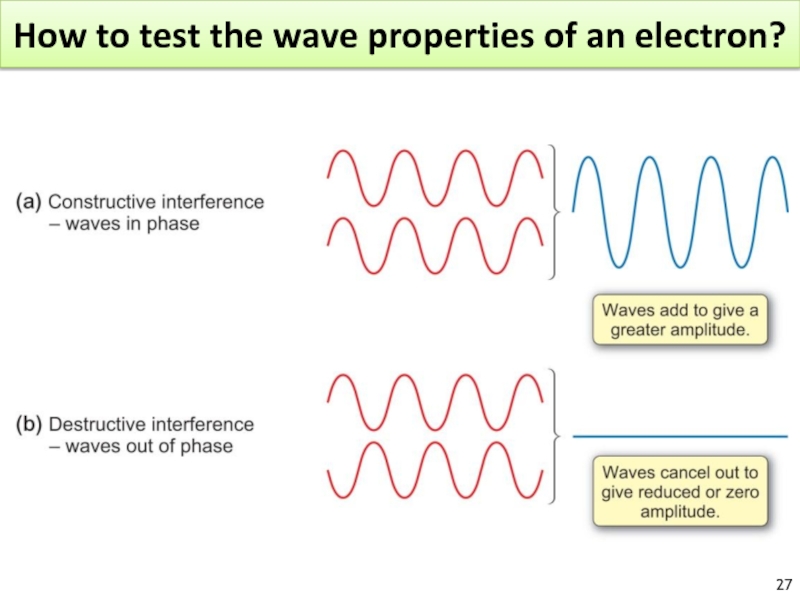
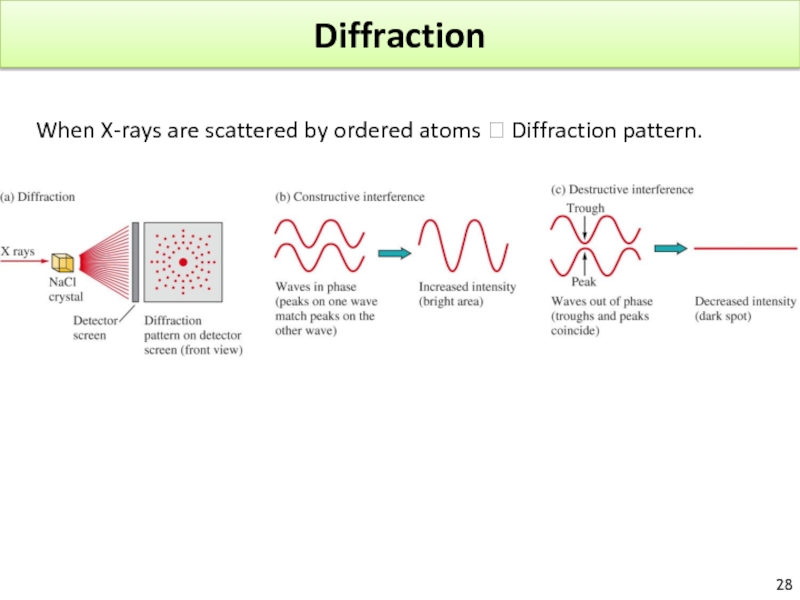
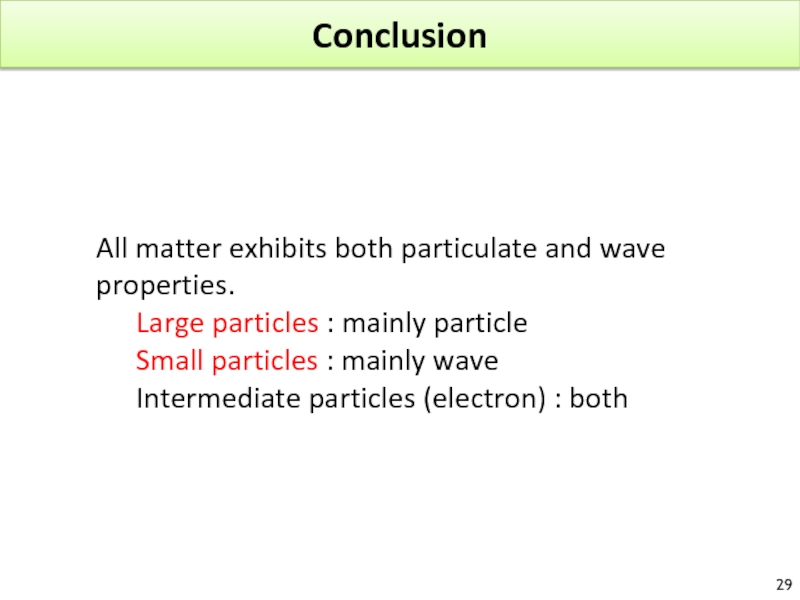

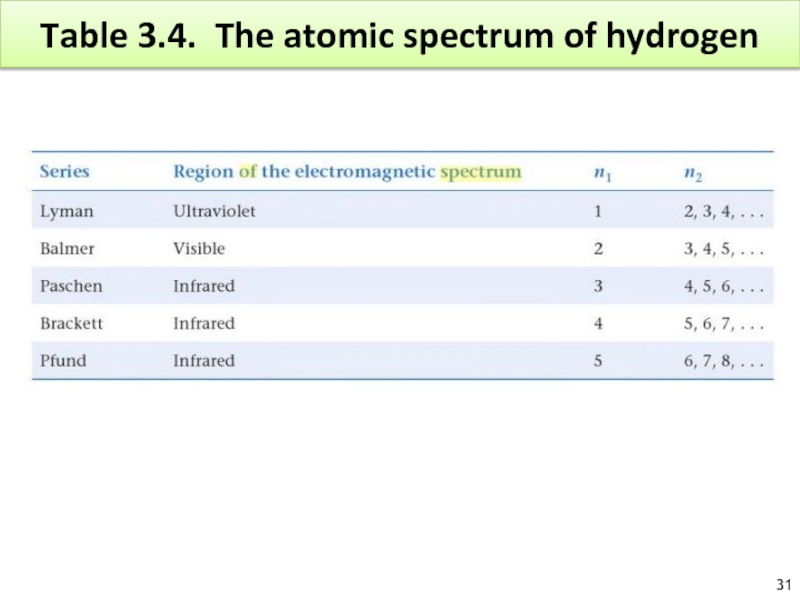
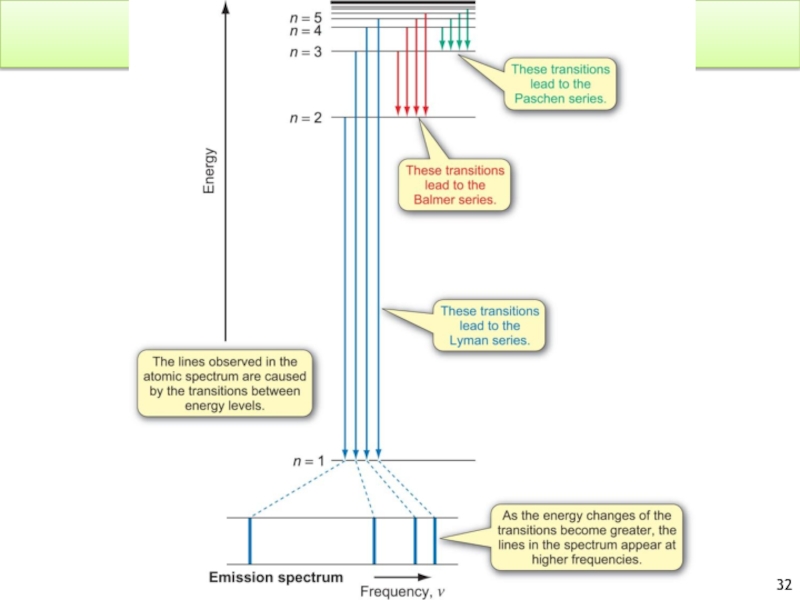
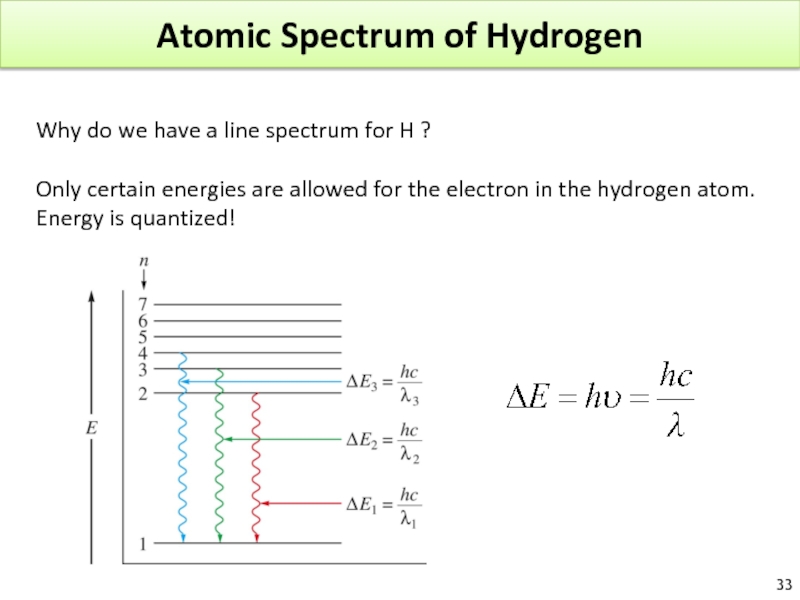
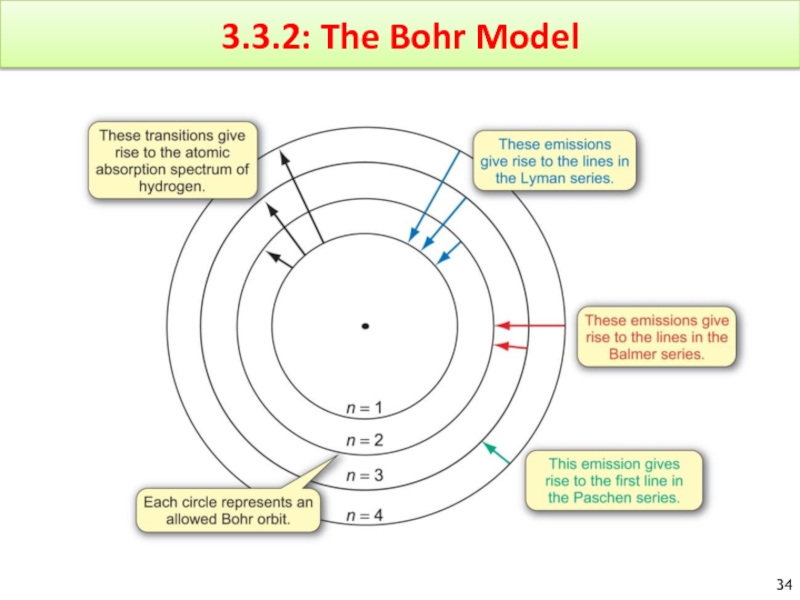
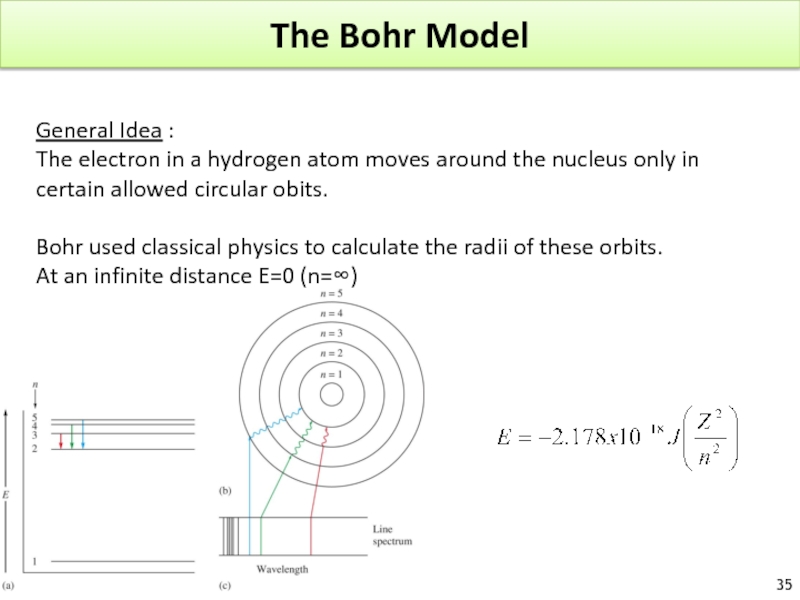
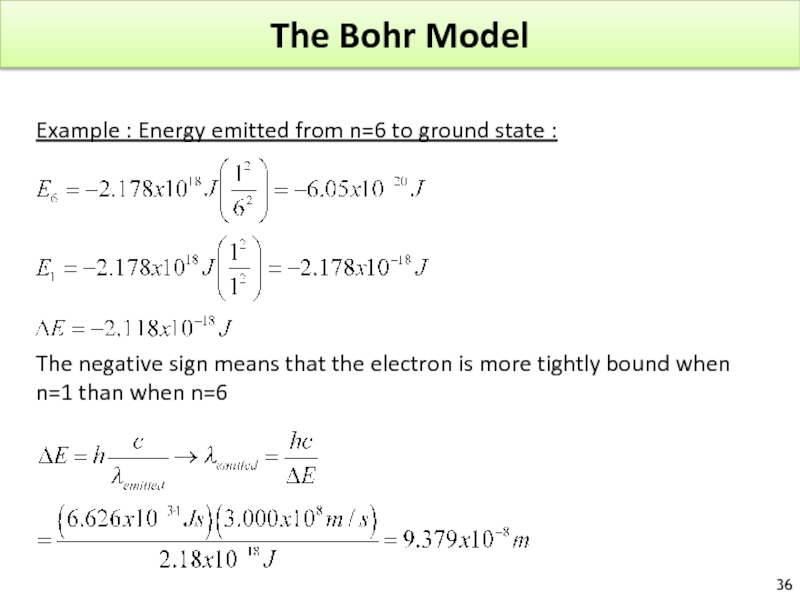
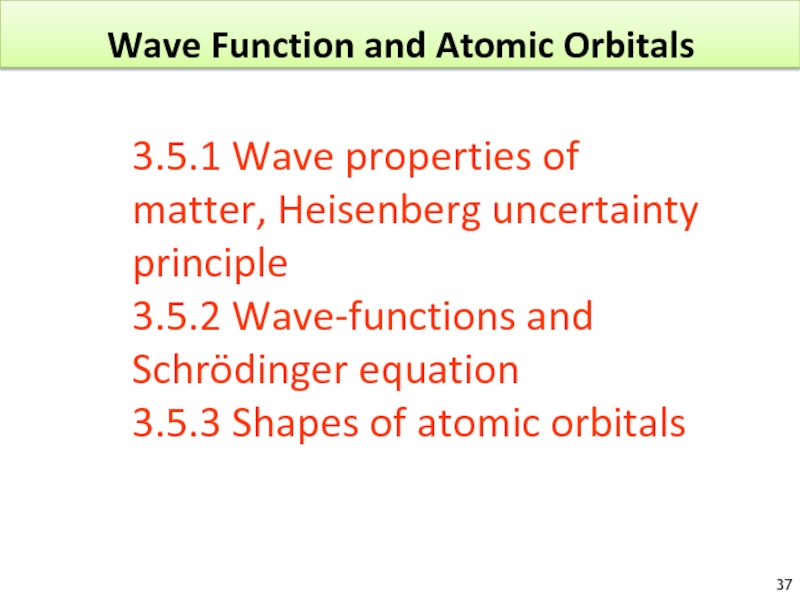
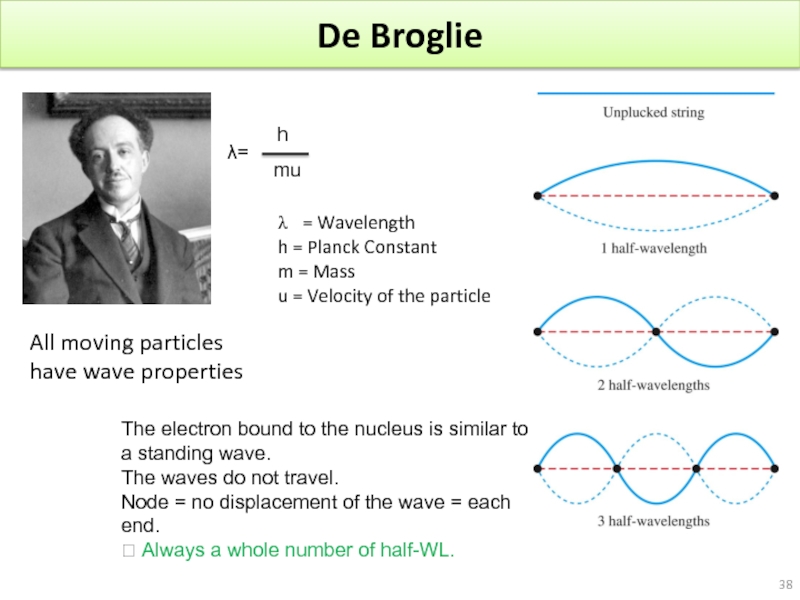
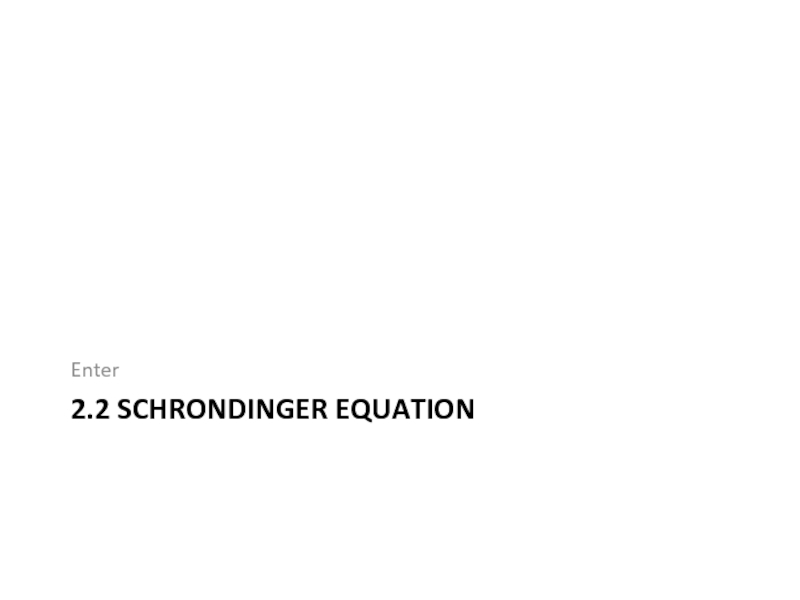
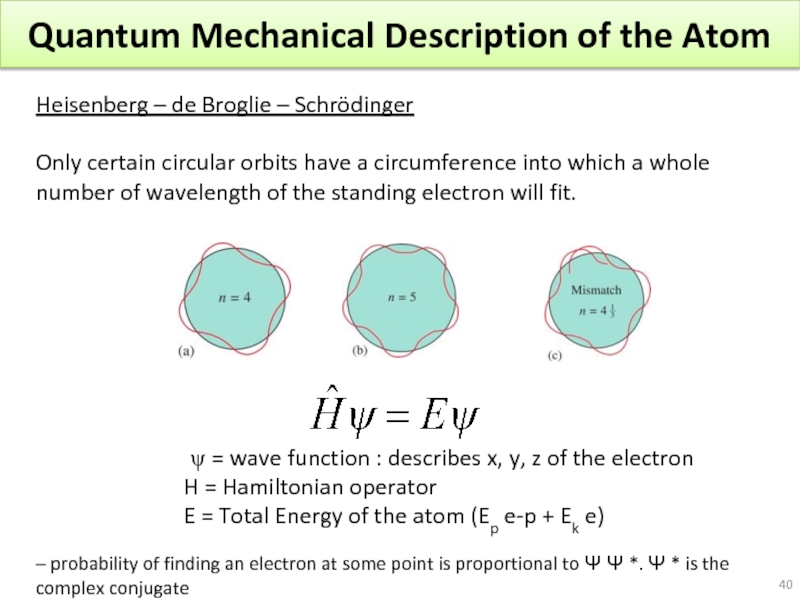
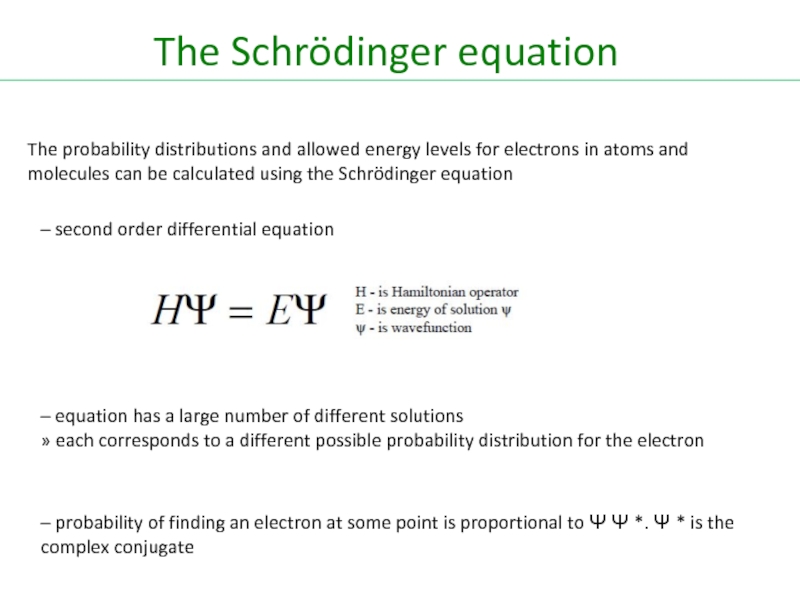
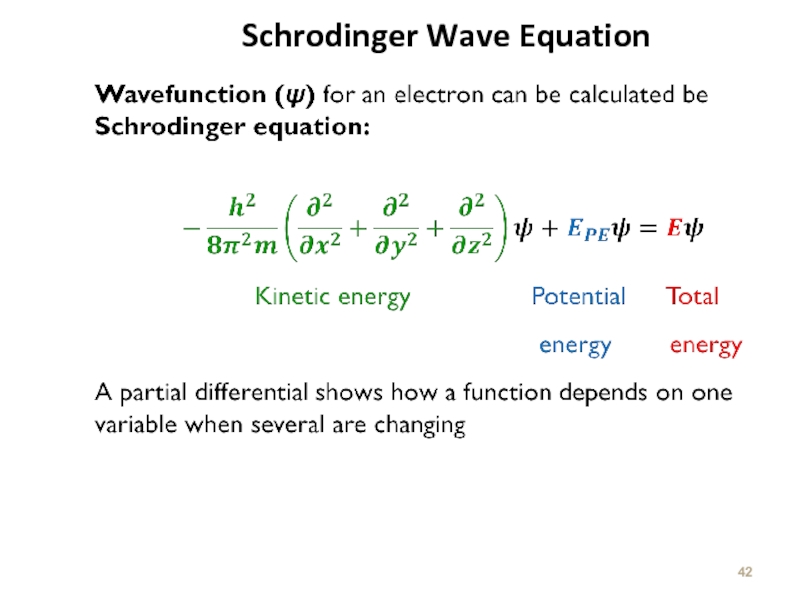
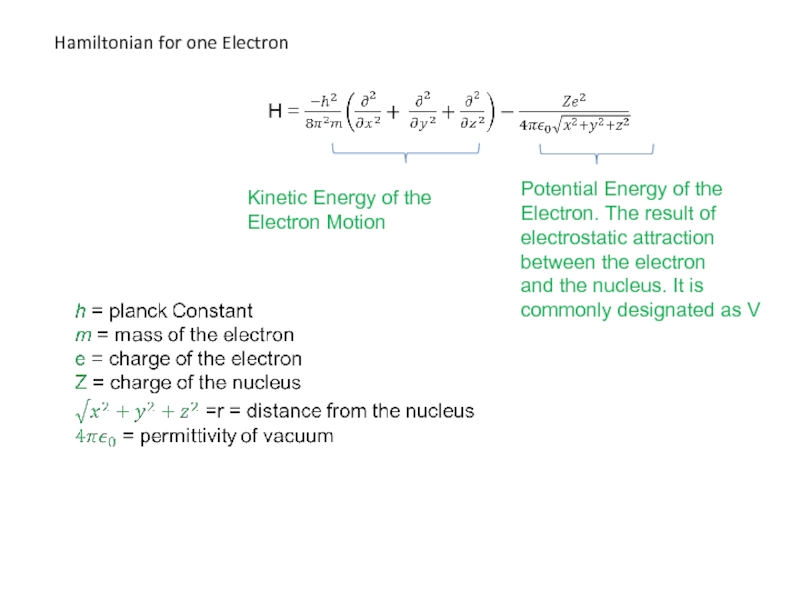
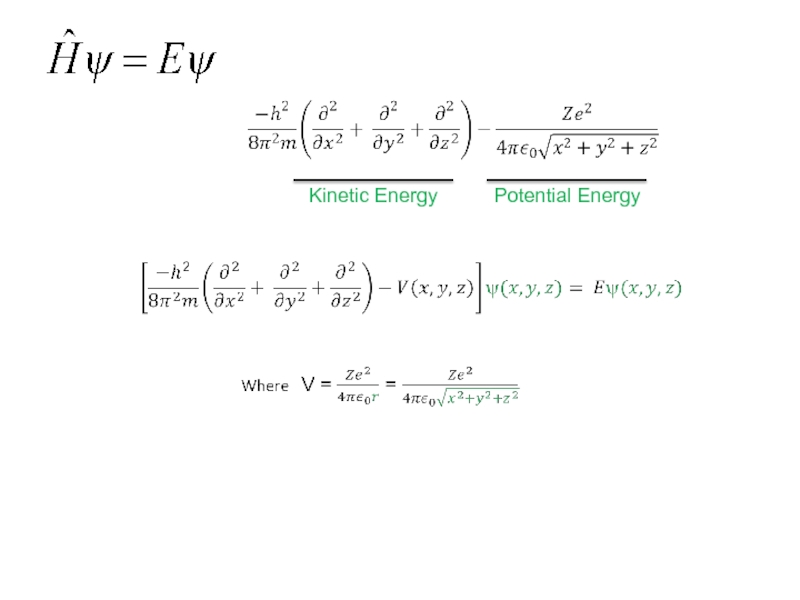
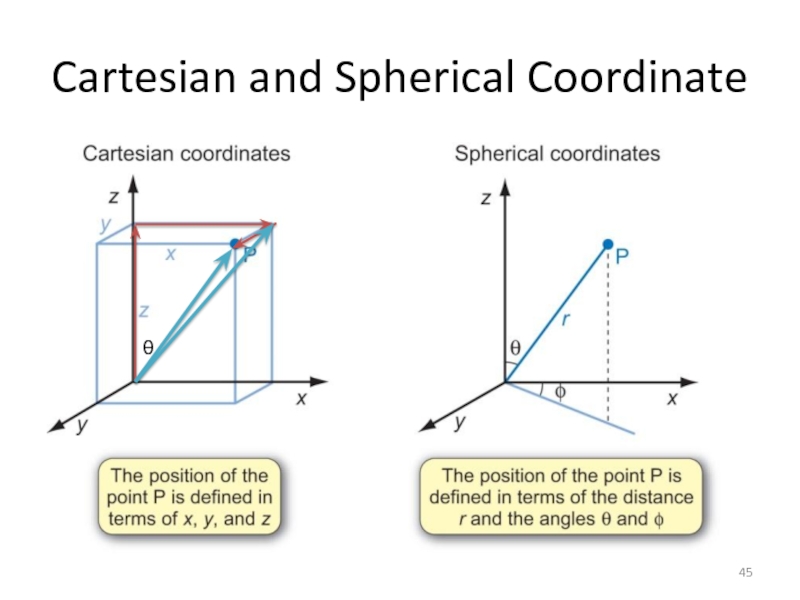
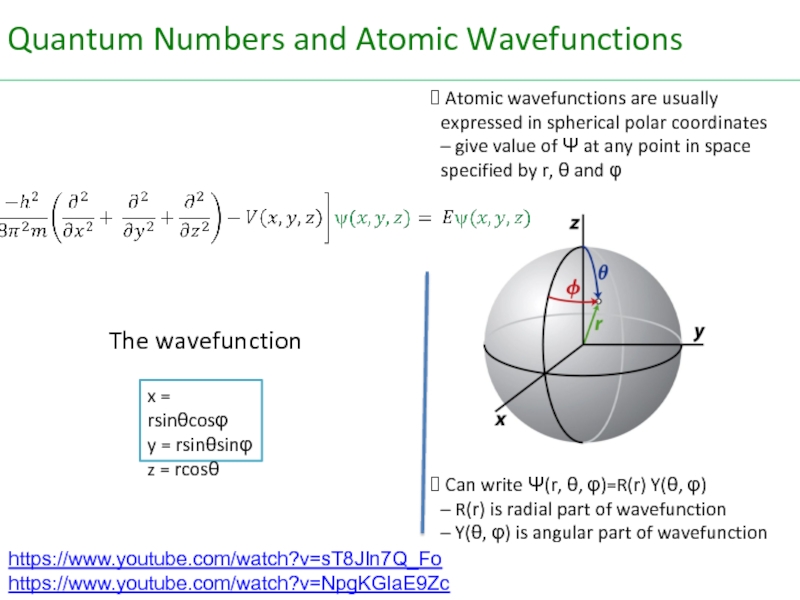
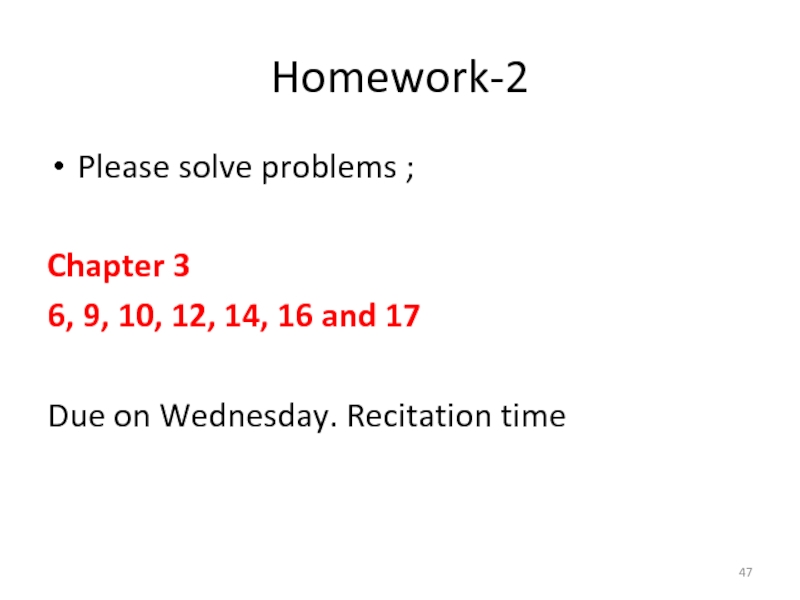
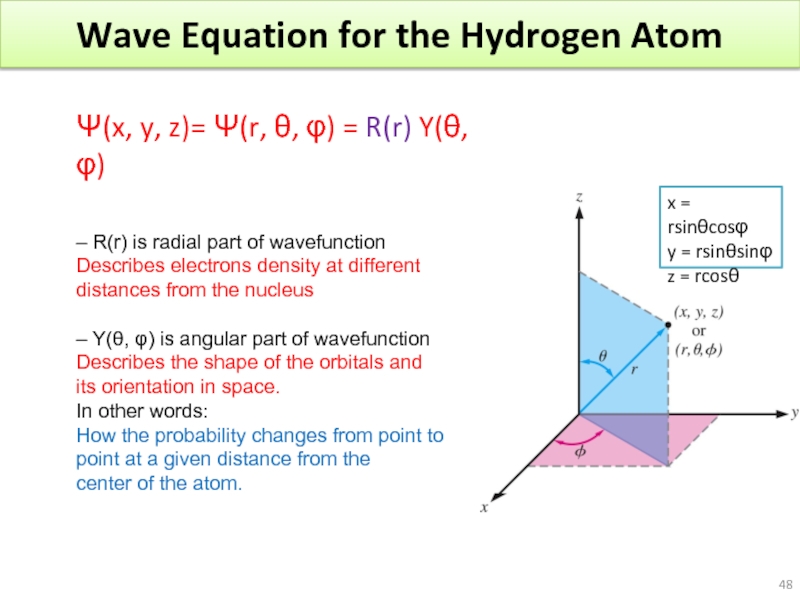
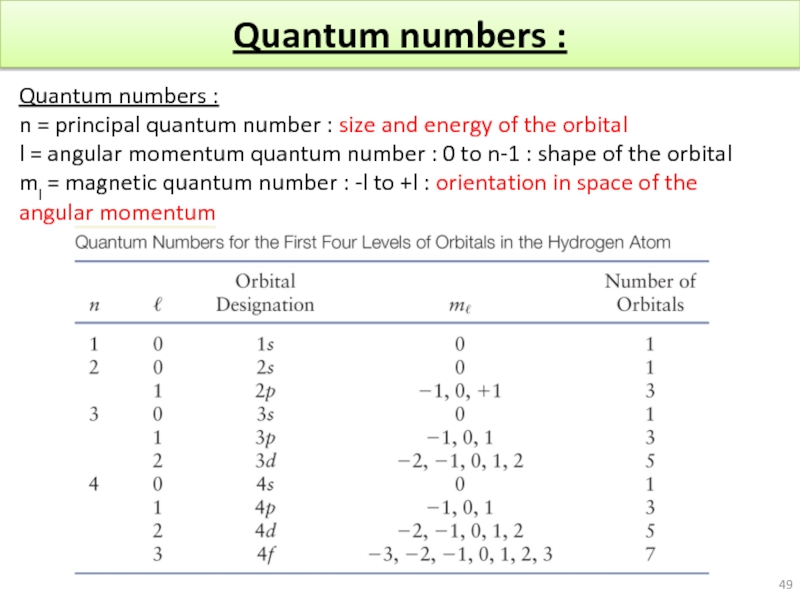
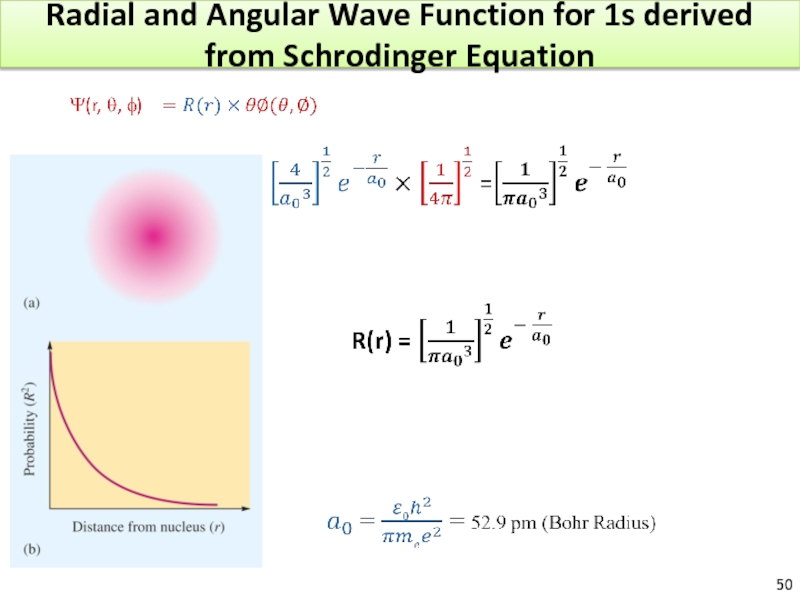
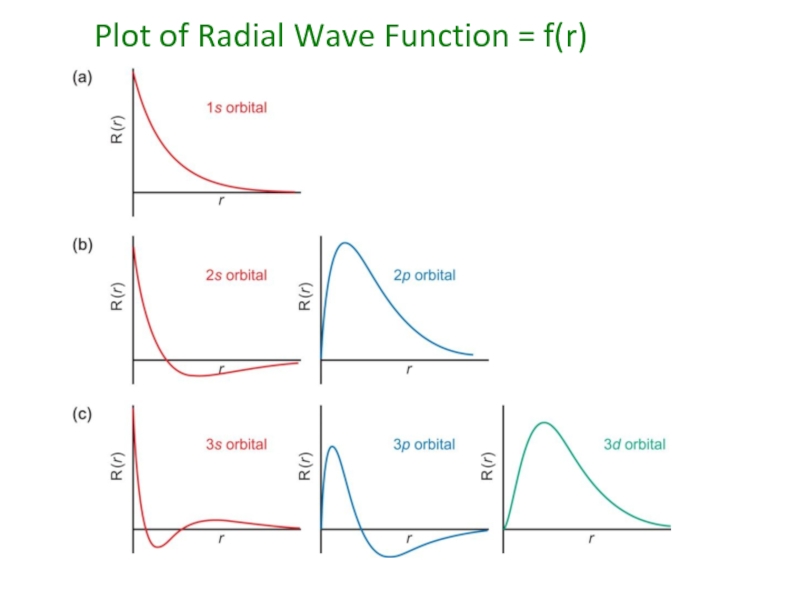
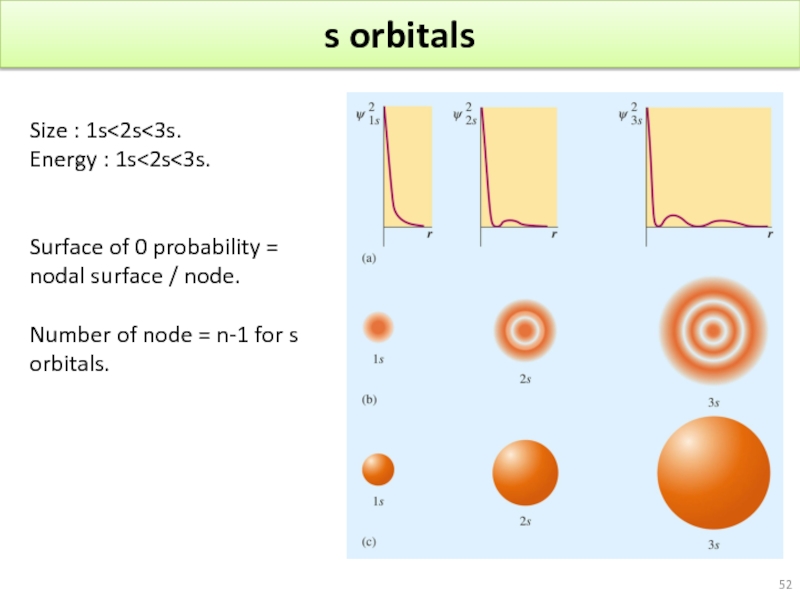
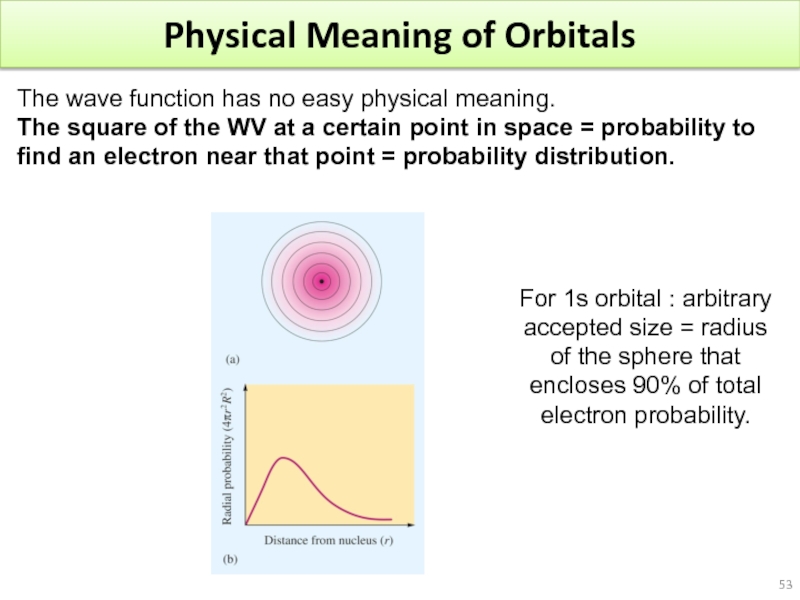
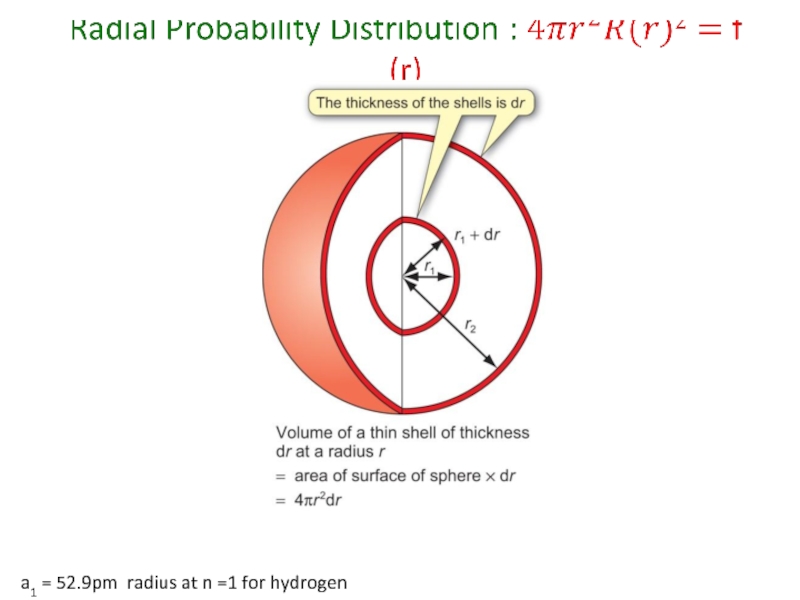
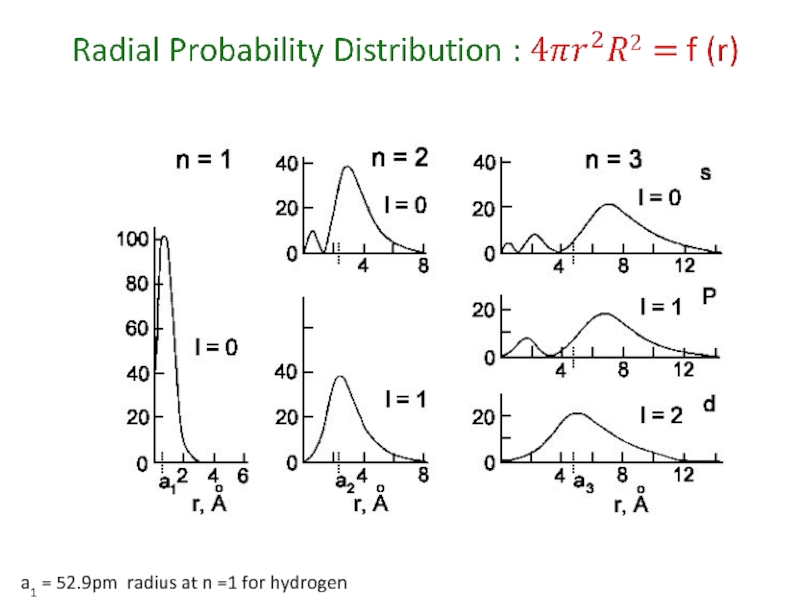
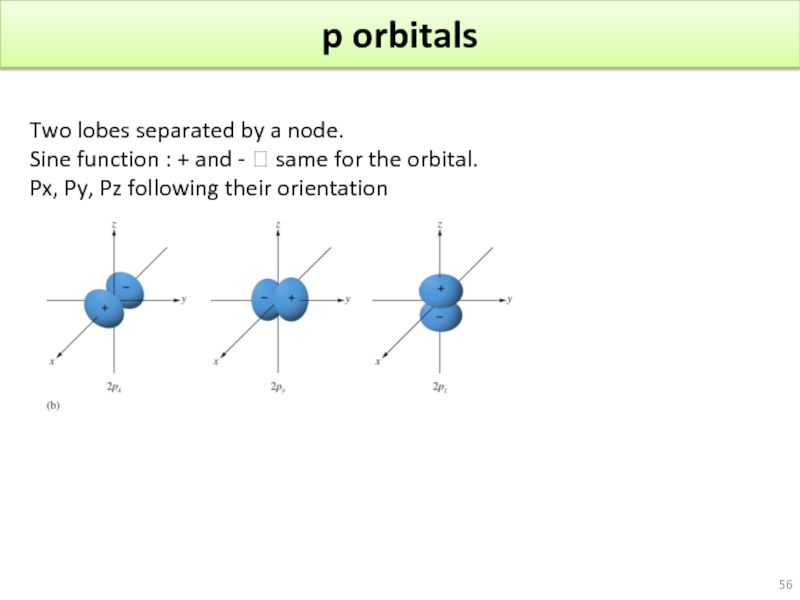
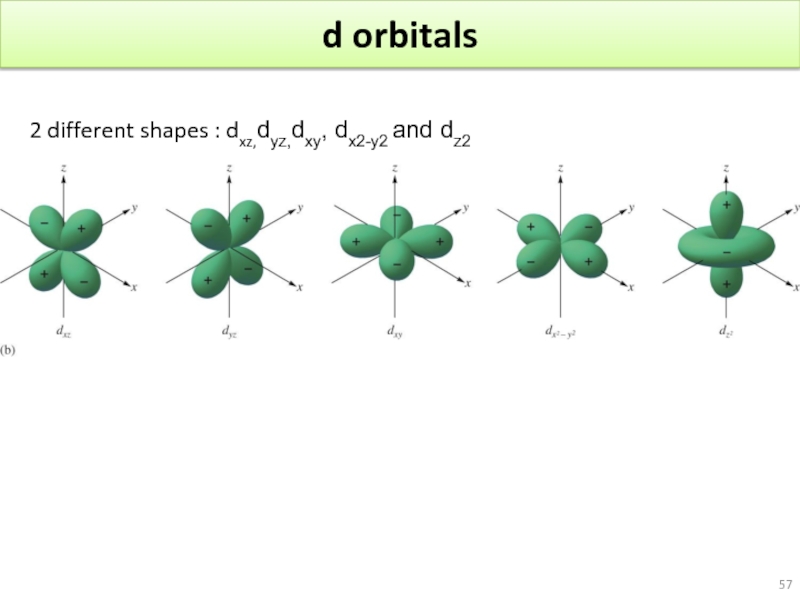
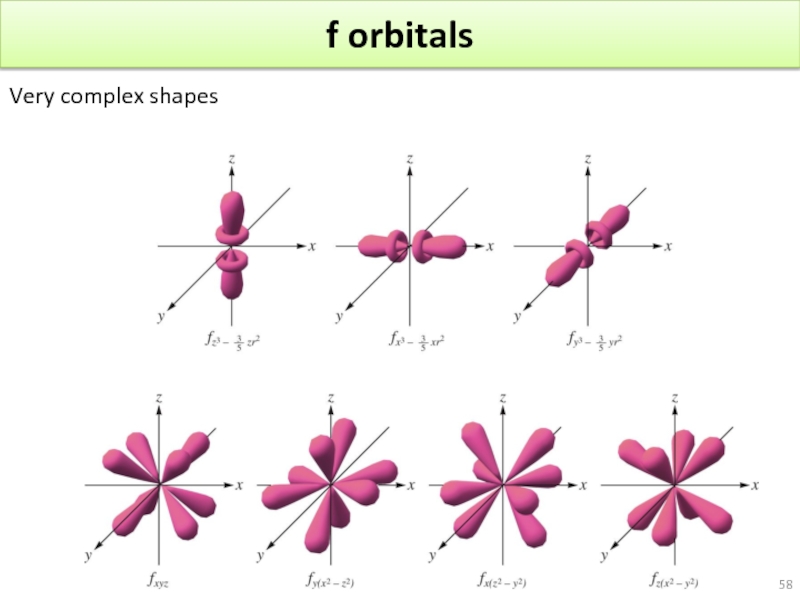
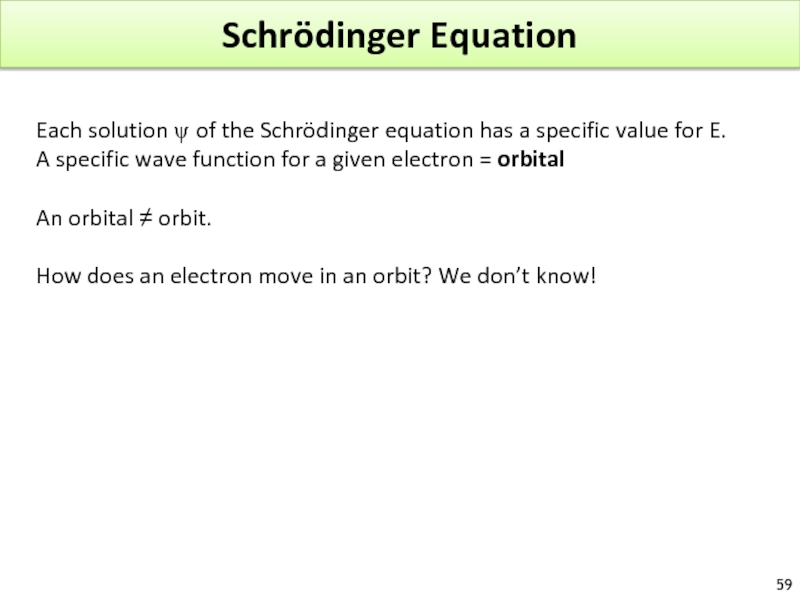
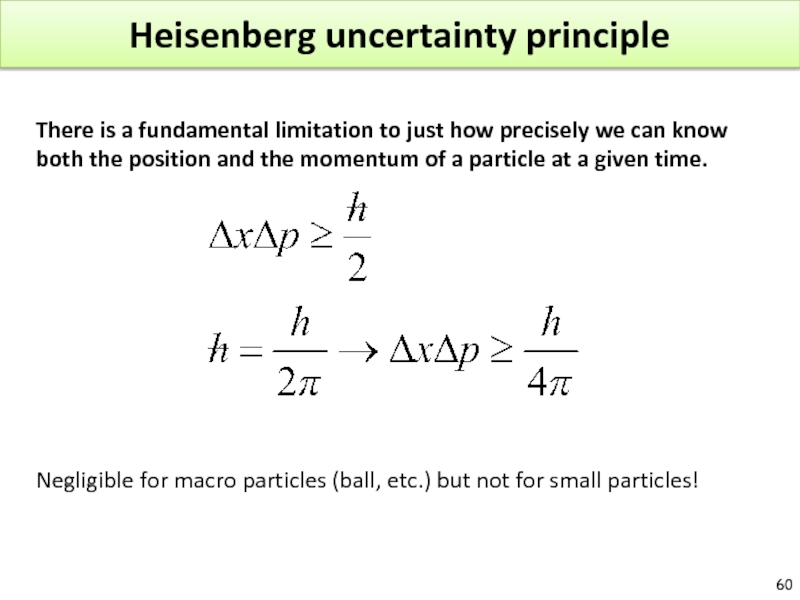
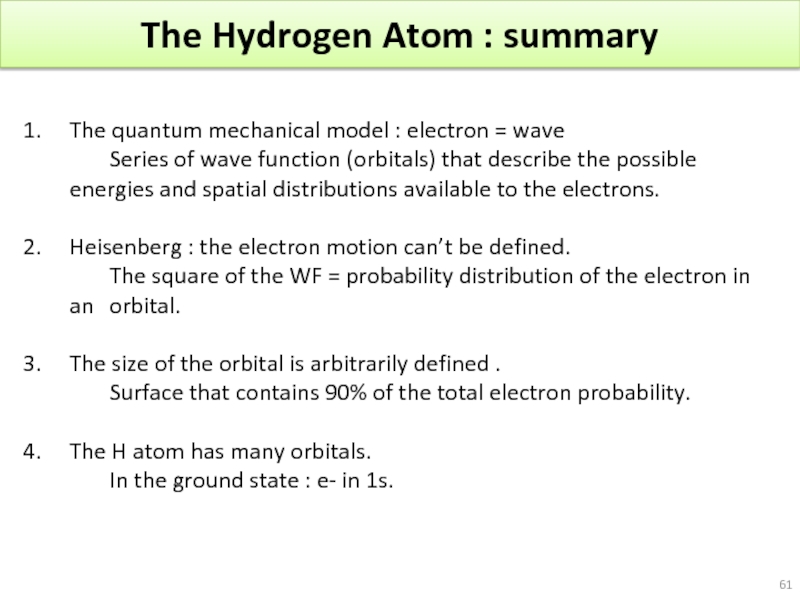
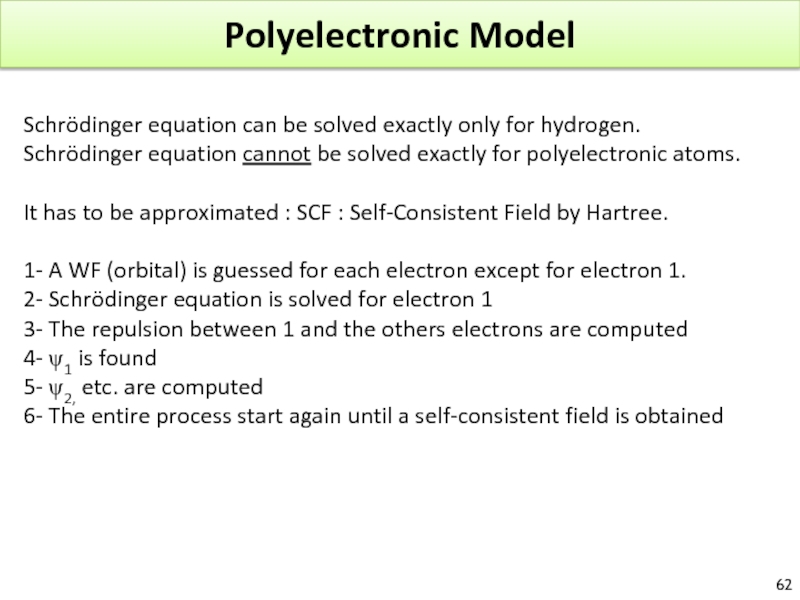
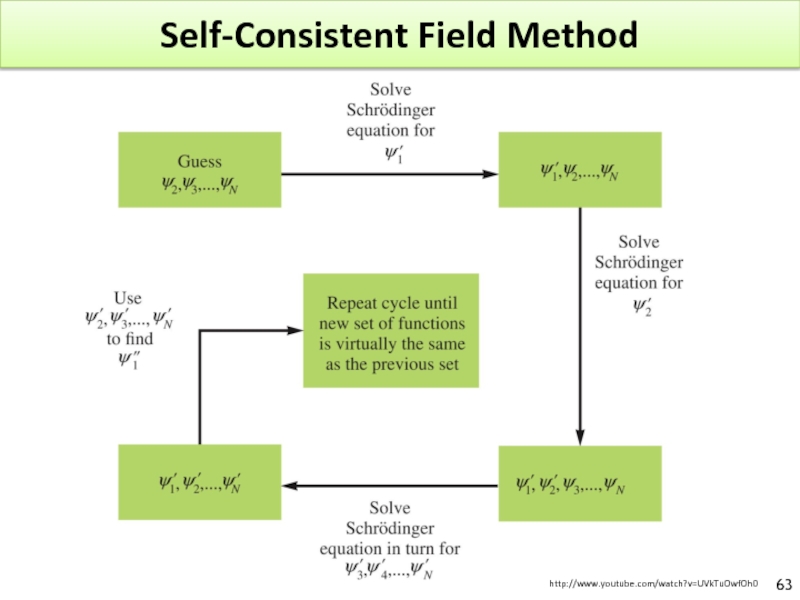

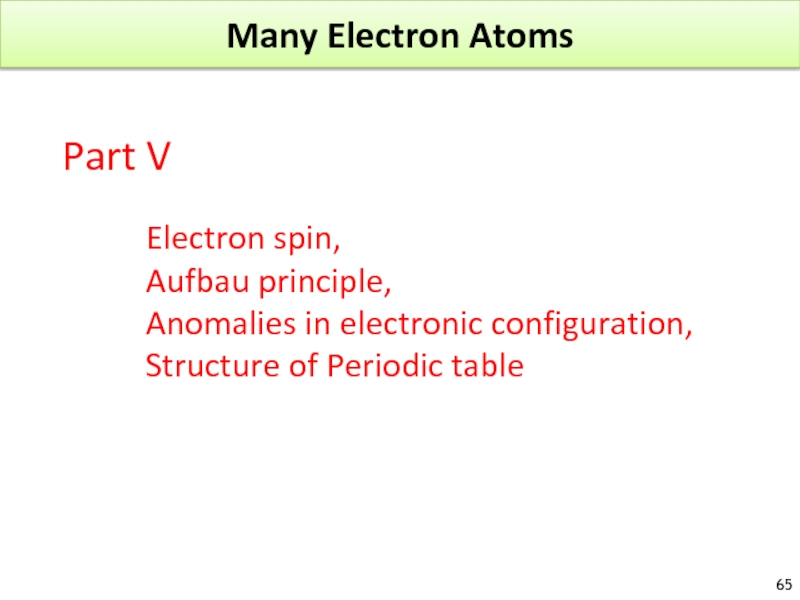
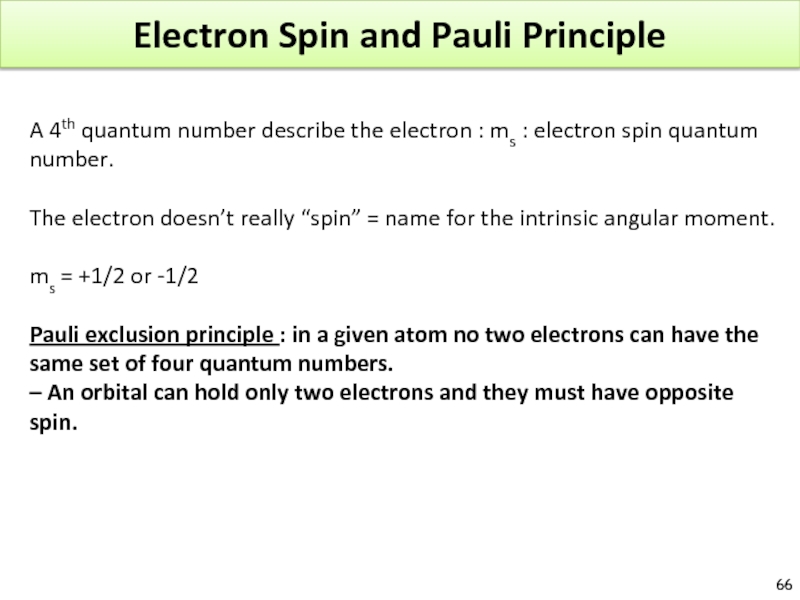
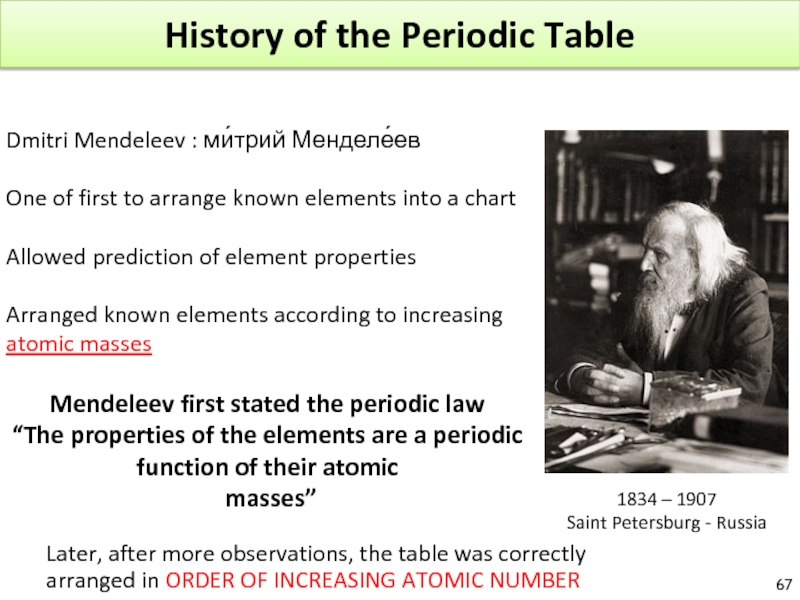
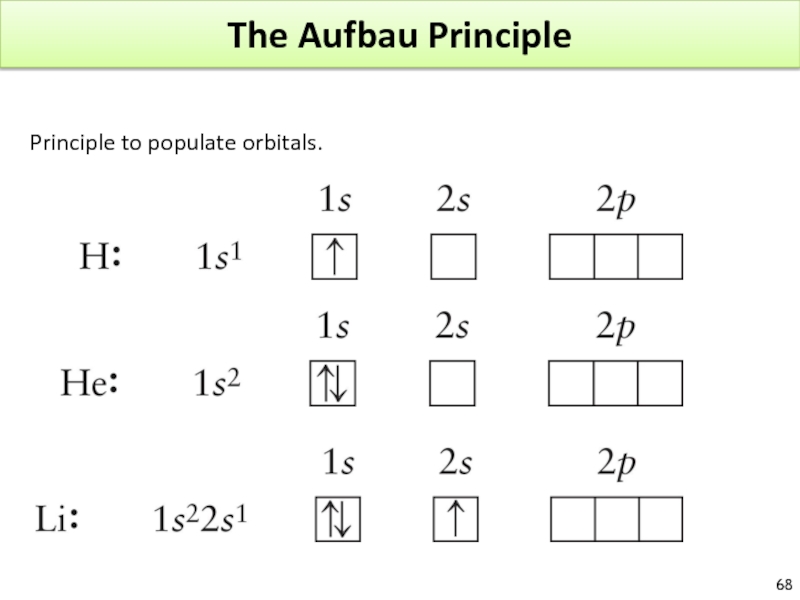
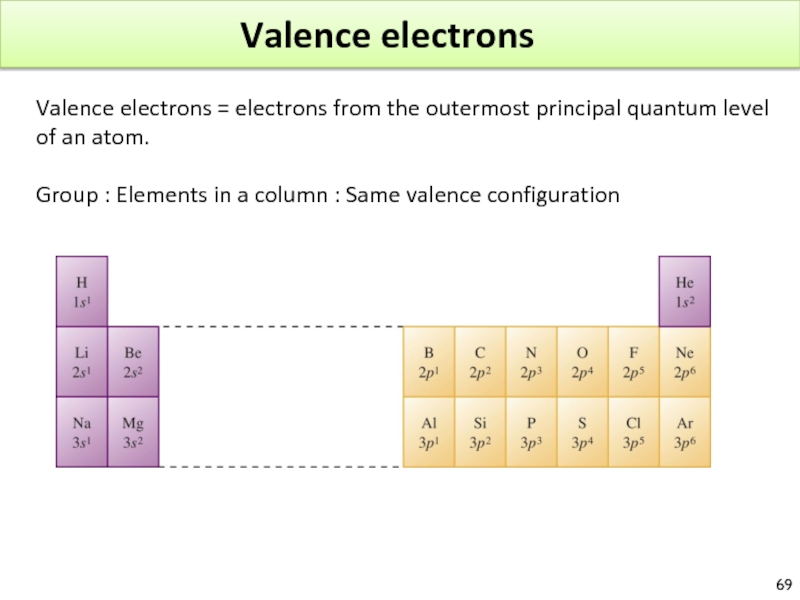
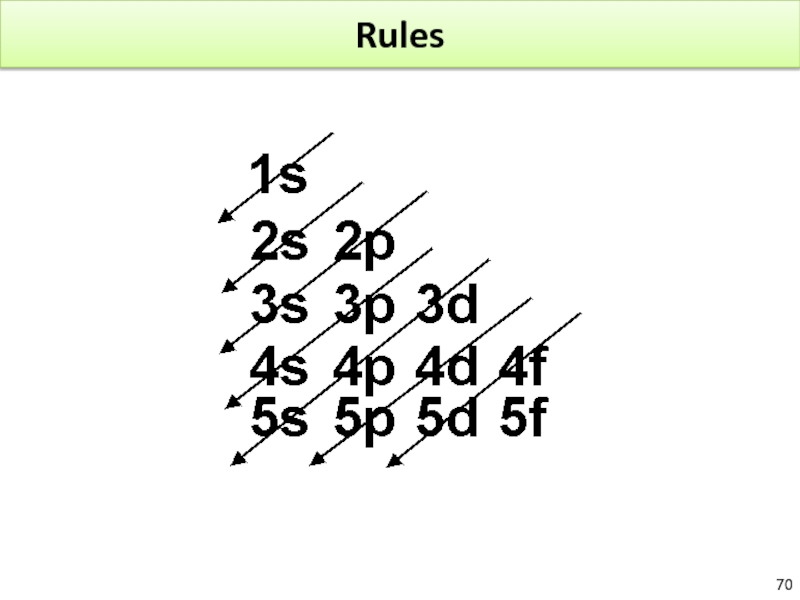
![RulesAfter 4s2, we fill 3d.Mn : [Ar]4s23d5 – Fe [Ar]4s23d6Additional Rules:The (n+1) orbitals always fill](/img/tmb/1/31356/c006b4bbadc299a0b2841ac5294eeed7-800x.jpg)

